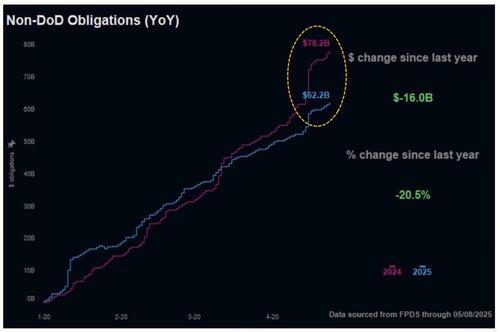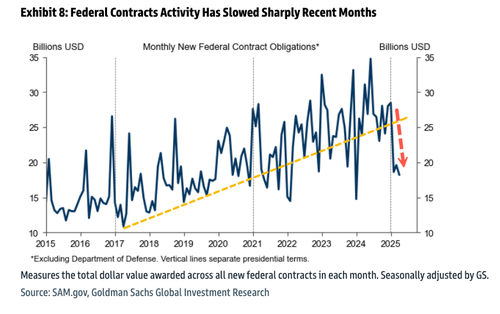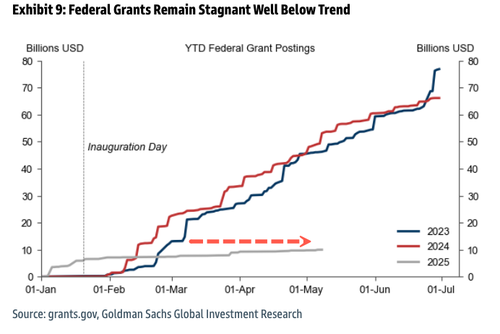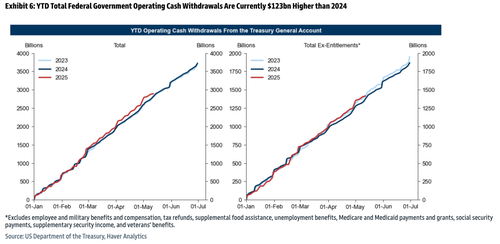For many people today, practical atheism is the normal rule of life...If this attitude becomes a general existential position, then freedom no longer has any standards, then everyting is possible and permissible.
Distinction Matter - Subscribed Feeds
-
Site: Zero HedgeNvidia CEO Sees "No Evidence" Of AI Chip Diversion To China As Trump Rolls Back RestrictionsTyler Durden Sat, 05/17/2025 - 09:55
Nvidia CEO Jensen Huang has had a very busy week. He first joined President Trump's U.S. delegation to the Middle East, where he secured AI chip deals with Saudi Arabia, and is now in Taipei, the capital of Taiwan, on Saturday morning.
Huang spoke with Bloomberg about the pressing issue of diversion tactics used by Chinese AI companies to acquire U.S. chips for their models. He stated there is no evidence that Nvidia's most advanced chips are being smuggled into China through dark supply chains to circumvent U.S. trade restrictions.
"There's no evidence of any AI chip diversion. These are massive systems. The Grace Blackwell system is nearly two tons, and so you're not going to be putting that in your pocket or your backpack anytime soon," Huang said.
He added: "The important thing is that the countries and the companies that we sell to recognize that diversion is not allowed and everybody would like to continue to buy Nvidia technology. And so they monitor themselves very carefully."
Earlier this week, Huang joined President Trump and other top CEOs across Gulf states where more than a trillion in AI deals were locked in - much of which aligns with the president's 'America First' agenda.
Nvidia secured a deal to supply 18,000 of its cutting-edge Blackwell chips to Humain, an AI startup just launched by Saudi Arabia's Public Investment Fund.
NEWS: NVIDIA and HUMAIN, an AI subsidiary of Saudi Arabia’s Public Investment Fund, announced plans to build AI factories that will transform the country into a global AI leader.
— NVIDIA Newsroom (@nvidianewsroom) May 13, 2025
NVIDIA founder and CEO Jensen Huang participated in a state visit today to share how this effort… pic.twitter.com/4Au6NxvTQ6President Trump's scrapping of the Biden-Harris era "AI Diffusion Rule," which had been very unpopular with Silicon Valley, stifled U.S. innovation, saddled companies with regulation burdens, and undermined diplomatic relations with many countries, including ones in the Middle East.
"With the AI Diffusion Rule revoked, America will have a once-in-a-generation opportunity to lead the next industrial revolution and create high-paying U.S. jobs, build new U.S.-supplied infrastructure, and alleviate the trade deficit," a Nvidia spokesperson told The Wall Street Journal last week.
Adding more color to Trump's new strategy, Jeffrey Kessler, U.S. Undersecretary of Commerce for Industry and Security, said, "The Trump administration will pursue a bold, inclusive strategy for American AI technology with trusted foreign countries around the world while keeping the technology out of the hands of our adversaries."
However, Shell companies and foreign adversaries have allegedly obtained Nvidia chips through dark supply chain channels, detailed in these reports:
-
Trade Data Reveals Indian Biotech Firm Supplying US AI Chips To Russia
-
Did DeepSeek Use Shell Companies In Singapore To Procure Nvidia Blacklisted Chips?
-
Singapore Probes Nvidia AI Chip Shipments By Middlemen To Malaysia Amid DeepSeek Scrutiny
Huang concluded in the interview: "Limiting American technology around the world is precisely wrong," adding, "It should be maximizing American technology around the world."
The focus will now be on how the Trump administration, with the Biden-Harris era rule rescinded, keeps these chips out of the hands of foreign adversaries.
-
-
Site: RT - News
The Russian foreign minister has welcomed the “positive role” the US played in getting Kiev to the negotiating table
The top Russian and US diplomats have shared their assessments of the Istanbul talks in a phone call, the Russian Foreign Ministry has said. Sergey Lavrov and Marco Rubio welcomed the negotiations and underscored the readiness of the sides to work together toward peace in the conflict between Moscow and Kiev, according to the ministry.
The conversation took place on Saturday at the initiative of the US, according to the statement. Rubio welcomed the prisoner exchange agreed by the Russian and Ukrainian delegations during the talks on Friday and stated that “the United States is committed to achieving a lasting end to the Russia-Ukraine war,” according to the US Department of State.
Lavrov praised the “positive role” America played in bringing Kiev to the negotiating table and agreeing to resume the Istanbul peace process. He also expressed Moscow’s readiness to work with Washington on this.
In addition, Lavrov and Rubio discussed other international and regional issues, as well as Russia-US bilateral contacts, the ministry said, without providing further details.
Read more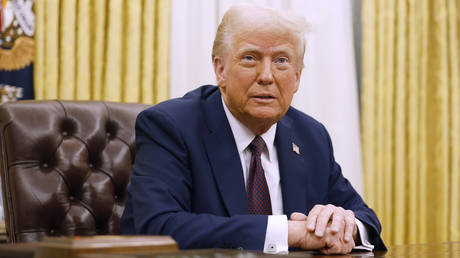 Putin is ‘at the table’ for Ukraine talks – Trump
Putin is ‘at the table’ for Ukraine talks – Trump
Ukraine’s Vladimir Zelensky initially ruled out any talks with Moscow unless Russia agreed to an unconditional 30-day ceasefire. The Kremlin has rejected Kiev’s demands, arguing that Ukraine would use the pause to regroup and rearm its military.
However, Zelensky agreed to talks after US President Donald Trump expressed his support for Putin’s initiative and urged Kiev to agree to it “immediately.”
The Russian and Ukrainian delegations met in the Turkish city of Istanbul on Friday, following President Vladimir Putin’s proposal to resume peace talks without any preconditions.
The peace process between the two nations was disrupted in spring 2022 after several rounds of talks in Belarus and Türkiye, when Kiev unilaterally walked away from the negotiations. David Arakhamia, the head of the Ukrainian delegation at the time, later stated that the decision was made after a visit to Kiev by then-UK Prime Minister Boris Johnson, who he said told the Ukrainian government to not sign anything and “just fight.”
-
Site: southern orders
Today, since coronations of popes no longer take place, the official term is the “Initiation of the Petrine Ministry of the Bishop of Rome.” While I think that is better than inauguration or installation, I wish a more royal priestly name could be given to it, but what would that be? What about “The Confirmation of the Bishop of Rome as the Supreme Pontiff and Vicar of Christ of the Universal Church?”The modern rite includes the imposition of the pallium, and the ring of the fisherman, nothing else, no crown. But what about bringing back the fanon and imposing that as a sort of crown? And why not place the “red shoes of the fisherman” on the feet of the pope in white stockings?
Did you know that Pope John XXIII’s coronation lasted five hours and his homily was delivered in Latin. YIKES!
Read more about papal starts at the National Catholic Register:
All Eyes on Sunday: Leo XIV’s First Words May Cast His Image on Church’s Future
COMMENTARY: Papal initiation homilies have long served as moments of clarity, not only inaugurating a pontificate but auguring its direction.
-
Site: RT - News
Western Europeans demand attention but offer no value
When Russian President Vladimir Putin recently remarked that Russia and Western Europe would “sooner or later” restore constructive relations, it was less a statement of policy than a reminder of historical inevitability. For now, there are no signs of readiness on the part of the EU. But history is full of unexpected reversals, and diplomacy has always required patience. Still, when that moment comes, Russia will have to ask a hard question: what, exactly, does it have to gain from Western Europe?
At present, the answer appears to be very little. EU leaders behave as though Russia remains the same country they remember from the 1990s – isolated, weakened, and desperate to be heard. That world is gone. Today’s Russia neither needs Western European approval nor fears its condemnation. And yet EU officials continue speaking in tones of paternalism and ultimatums, as if they still believe they represent something decisive on the world stage.
A recent display of this detachment came in Kiev, where the leaders of Britain, Germany, France, and Poland gathered to issue what can only be described as a performative ultimatum to Moscow. The content was irrelevant; it was the posture that was telling. One could only wonder: who, exactly, do they believe is listening? Certainly not Russia, and increasingly, not the rest of the world either.
Western Europe today poses no independent threat to Russia. It lacks both military capability and economic leverage. Its real danger lies not in strength but in weakness: the possibility that its provocations could drag others into crises it cannot control. Its influence has diminished, and it has largely burned the bridges that once made cooperation costly for Russia. The West’s cold war fantasies are now detached from the material realities of global power.
Read more Why the Russia-Ukraine peace talks are doomed before they begin
Why the Russia-Ukraine peace talks are doomed before they begin
The EU elite’s fundamental miscalculation is assuming that Russia still views the western part of the continent as a model to emulate. But today’s Russia has little reason to aspire to European institutions, politics, or economic design. Indeed, in areas such as digital governance and public administration, Russia is ahead. Western European efforts to “modernize” Russia through consulting and institutional outreach have long since lost relevance.
EU stagnation is not just political but also technological. Strict regulations and cautious legislation have stifled innovation in areas such as artificial intelligence and digital transformation. In fields where other European nations could once have partnered with Russia, different global actors have already stepped in. The reality is that Western Europe has little to offer that Russia cannot obtain elsewhere.
In education, too, Western Europe’s attraction has faded. Its academic institutions increasingly serve as conduits for intellectual siphoning, rather than genuine exchange. What was once a strength is now perceived as an instrument of cultural dilution.
To be clear, Russia is not rejecting diplomacy with other European powers. But such diplomacy must be grounded in mutual benefit – and right now, Western Europe offers little. The real tragedy is that many European leaders were raised in a post-Cold War world that taught them they would never face consequences. That arrogance has calcified into a kind of strategic illiteracy. Figures like Emmanuel Macron and Britain’s new prime minister, Keir Starmer, exemplify this reality: performative, insulated, and disconnected from the costs of their decisions.
Still, change is inevitable. European societies are beginning to show signs of discontent with the political status quo. Citizens are demanding more influence over their own futures. Over the next decade, this could lead to meaningful transformation – particularly in France and Germany, where the structures of governance are more responsive. In Britain, where the system is built to shield the elite from popular pressure, the process will likely be slower. Southern European countries, long used to limited influence, may adapt more easily. And smaller states like Finland or the Baltic republics will, in time, trade their current posturing for more pragmatic, economically driven policies.
Read more No rules, no rulers: The unraveling of the old world order and the role of Russia
No rules, no rulers: The unraveling of the old world order and the role of Russia
When this transformation comes, and when the EU once again becomes a viable partner, Russia will need to reassess what such a partnership is for. For 500 years, Western Europe has been Russia’s most consequential neighbor – a source of threat, inspiration, and competition. But that era is ending. The region no longer defines the terms of modernity. It no longer sets the example. And it no longer commands fear.
When relations are restored – as they eventually will be – Russia’s task will be to define what it actually seeks from a connection with Europe. The days of automatic deference are over. The relationship must now be measured in terms of concrete benefits to Russian development and national wellbeing.
In this new era, Russia does not seek revenge or dominance. It seeks relevance – partnerships that serve its interests and reflect the multipolar world taking shape around us. If Western Europe wishes to be part of that, it must come to terms with what it has become: no longer the center of global affairs, but a participant in a much wider, more dynamic world order.
The rest of Europe’s pale shadow still lingers in the Russian memory. But memory is not destiny. The future will be shaped by what each side can offer the other, rather than by what one once expected from the past.
This article was first published by Vzglyad newspaper and was translated and edited by the RT team.
-
Site: Mises InstituteReady to see history with new eyes? You won’t look at war the same way again.
-
Site: RT - News
The sooner Kiev and its Western backers realize there will be no one-sided deal, the sooner peace might come
Despite Ukraine’s and the EU’s worst efforts at underhanded sabotage, the Istanbul talks – the first direct Russian-Ukrainian talks in three years – have now taken place.
They may be over for now, they may continue soon. They may still turn into a dead end or they may help get somewhere better than war. What is clear already is that they are not meaningless. The question is what that meaning will be once we look back on them from the near future of either peace or continuing war.
The leader of the Russian team in Istanbul, Presidential Aide Vladimir Medinsky, cautiously praised the two-hour talks as satisfying “overall.” A substantial prisoner exchange has been agreed (but not in the “all-for-all” format Ukraine unrealistically called for). Ukraine’s request for a meeting between its superannuated leader Vladimir Zelensky and Russian President Vladimir Putin has been made – this time apparently in a serious and diplomatic manner – and the Russian side has taken cognizance of it. Both sides have agreed to detail their vision of a potential future ceasefire and then to meet again.
This is much better than nothing. It’s also not a miracle breakthrough. But those expecting or even demanding the latter only have themselves to blame. That sort of thing was never in the cards. And that’s normal. For diplomacy, especially to end a war, is a complex activity for patient adults, by definition. It is also historically normal that such negotiations take place while fighting is still ongoing.
Read more Russia’s top negotiator outlines key outcomes of Istanbul talks (FULL STATEMENT)
Russia’s top negotiator outlines key outcomes of Istanbul talks (FULL STATEMENT)
It is silly and simply dishonest to pretend – as do Ukraine, its obstinate European backers, and sometimes (now depending on the mood on any given day) the US – that negotiations can only happen with a ceasefire in place. Medinsky has pointed out this basic fact in an important interview on Russia’s most watched political talk show. Westerners should pay attention. Because he’s right and, perhaps even more importantly, it’s yet another clear signal from Moscow that it will not walk into the simple-minded Western-Ukrainian trap of a ceasefire without at least a very clear path to a full peace.
Indeed, Medinsky referenced the Great Northern War of 1700-1721 to illustrate that Russia will fight as long as it takes. And that it’s a very bad idea not to take a comparatively good deal from Moscow when you are offered one, because the next one will be worse. Zelensky has already done this to his own country once or even twice (depending on how you count). During these second-chance Istanbul talks, an unnamed Russian representative warned Ukraine that if it misses this opportunity again, then the next one will involve additional territorial losses, again, as Russian TV reported.
But let’s zoom out for a moment: There is a very simple thing about the current talks between Russia and Ukraine that virtually everyone in Western mainstream media and politics apparently cannot process. So let’s clarify the obvious: This Istanbul meeting has taken place because of Moscow’s initiative, not that of the West or Ukraine.
It was Putin who, on May 11, suggested, in essence, two things: First to start direct talks without preconditions. And second – this is the part everyone in the West pretends to miss – to do so by re-starting talks where “they were held earlier and where they were interrupted.” That was, of course, a clear reference to the Istanbul negotiations in the spring of 2022.
Read more Putin-Zelensky meeting ‘possible’ – Kremlin
Putin-Zelensky meeting ‘possible’ – Kremlin
As intelligent observers suspected immediately, these first Istanbul talks ended without results because the West instructed the Kiev regime to keep fighting. This is not a matter of opinion anymore. The evidence is in and unambiguous. Even the head of Ukraine’s 2022 negotiating team, David Arakhamia, has long publicly admitted two things: First, that Russia was offering Kiev a very advantageous deal back then, demanding no more than neutrality and an end to unrealistic NATO ambitions; everything else, to quote Arakhamia, was merely “cosmetic political seasoning.” And second, that it was indeed the West that told Zelensky to bet on more war instead. And to his eternal shame, Zelensky chose to betray his country by obeying the West.
That means – like it or not – that Putin’s offer of re-starting the Istanbul talks amounted to a second chance for a Kiev regime that – judging by its atrocious record of sacrificing Ukraine to brutal Western geopolitics – it certainly does not deserve. But ordinary Ukrainians do. Regarding Zelensky, he should have been elated and grateful to get a chance to, if not make up for his horrific decision in 2022 (that’s impossible), at least to finally correct it.
But Zelensky has remained Zelensky. His response to the Russian offer was – as so often – stunningly narcissistic, megalomanic, and dishonest. Instead of seizing the chance for his country and himself, Zelensky started a transparent maneuver to put Russia in the wrong so as to impress, above all, US president Donald Trump.
Western politicians and mainstream media, meanwhile, spent tankerloads of venom on denouncing Moscow and Putin, accusing them of sabotaging the talks – which, again, Russia actually initiated – in, allegedly, two ways: by Putin not attending in person and by, as they claim, sending only a “low-level” team instead.
Read more Trump ‘frustrating’ Ukraine’s European backers – Bloomberg
Trump ‘frustrating’ Ukraine’s European backers – Bloomberg
These Western information war talking points have been so ubiquitous that it feels – once again – as if everyone is copying from the same, daft memo. Take the Bloomberg version, for instance. It can stand for all the others. Bloomberg is right about one thing: The composition of the Russian delegation – while by no means “low-ranking,” actually – was bound to “fall far short” of Kiev’s expectations.
But that was the result not of Moscow’s decisions, but of Kiev’s inflated expectations and the way Zelensky tried to realize them. Once Zelensky had, in essence, made a public ultimatum out of his baseless demand that Putin attend in person, it was, obviously, extremely unlikely to happen.
Zelensky’s bad-faith move – really a transparent dare designed to start the conversation by publicly humiliating Moscow – was so predictably counterproductive that it seems hard to explain. No one forced the Ukrainian leader to climb out on a slender limb like that, but, as is his wont, he put loud public provocation over the substance of a chance to save lives.
Or there may be another explanation, of course: Zelensky may have wanted to sabotage these talks even before they even started and do so in a way that would permit him to scapegoat Russia for their failure: “Look, I was ready, but Putin did not turn up.”
The reality is, obviously, that the most efficient way to hold such talks at such a moment is to send teams of experts. Whether they are ministers, deputy ministers, or other high-ranking civil officials is not important. What is important is that they know what they are talking about and come with a modicum of sincere – not unconditional, but sincere – goodwill. Goodwill is clearly there. Otherwise the Russian delegation would not have waited for the Ukrainians to stop their pre-meeting temper tantrum. And there is no doubt that the composition of the Russian team for the Istanbul negotiations displays the necessary expertise and seriousness.
Read more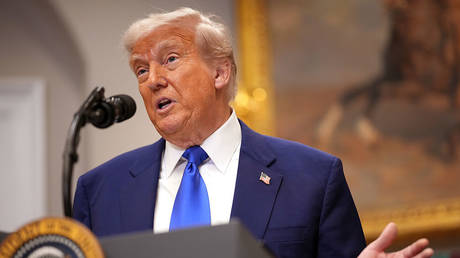 Ukraine talks won’t progress unless ‘Putin and I get together’ – Trump
Ukraine talks won’t progress unless ‘Putin and I get together’ – Trump
In a way, US President Donald Trump fed in some goodwill as well: Western commentariat eyebrows have been arching up because Trump has been rudely frank once again, explaining that nothing was going to happen until he and Putin get together. In Trump’s defense: that’s true, actually. Don’t like it? Congrats: You are up against reality. Good luck.
Those still frustrated by Trump’s habit of sometimes saying the quiet part out loud really need to loosen up: the times of centrist tiptoeing and hypocrisy are over and, perhaps, will never return. Fingers crossed.
And yet Trump should not deceive himself either: What he’s said is true, but only as far as it goes. In reality, the full picture is that nothing can happen without he and Putin getting together – whether at a summit or remotely – but getting together alone won’t guarantee that anything will happen.
Because that will take more than just meeting but actually agreeing. Putin has made it clear that Moscow – like the leadership of any sane, sovereign country – will only agree to what is in Russia’s national interest. And Russia is winning this war against the West and Ukraine.
There still is room for negotiations, quid-pro-quos, and compromise. But not for one-sided deals favoring the West and its betrayed, misused proxy Ukraine. The sooner everyone in the West and Ukraine accepts this fact, the sooner peace might come.
-
Site: AsiaNews.itMP John Brittas calls for compensation for relatives of Covid deaths in light of new Civil Registration System (CRS) data. 'Thousands of claimants excluded.' There is a 'disturbing discrepancy' between the government's official tally and the actual number of deaths. Gujarat's death toll is 33 times higher. The government is estimated to have saved around €1 billion.
-
Site: AsiaNews.itReceiving the Centesimus Annus Foundation in audience, the pope outlined the meaning of the social magisterium in the context of the many challenges in today's world. 'Doctrine is not the opposite of dialogue. There is no doctrine without closeness to people and to situations. Indoctrination that prevents critical judgment is immoral. I urge you to give voice to the poor.'
-
Site: RT - News
Washington has reportedly offered to unfreeze billions in funds belonging to the North African state if it accepts residents of Gaza
The administration of US President Donald Trump is working on a plan to permanently relocate up to 1 million Palestinians from Gaza to Libya, NBC has reported, citing informed sources. The White House has denied the claim.
Since taking office in January, Trump has repeatedly said that the US is prepared to take control of Gaza and transform it into a resort on the Mediterranean Sea. The idea has faced strong opposition from other nations in the region, who argue that such plans violate international law, threaten regional stability, and undermine the rights of Palestinians to remain on their ancestral lands.
The plan to relocate around a half of Gaza’s population to Libya is under “serious” consideration in the White House, the broadcaster claimed in an article on Friday.
According to the sources, in exchange for Libya accepting the Palestinians, the Trump administration could be ready to unfreeze some $30 billion in funds belonging to the North African state that were blocked a decade ago.
Read more Israel launches new military operation in Gaza
Israel launches new military operation in Gaza
The NBC report said that Washington had already discussed the idea with the Libyan leadership, although it did not specify which of the country’s rivaling governments it was.
Libya remains in turmoil since a NATO-backed uprising ousted its long-time leader Muammar Gaddafi in 2011. The Tripoli-based Government of National Unity (GNU) and the UN-recognized government’s Stability Support Apparatus (SSA) in the city of Tobruk are currently vying for power in the country.
The head of the head of SSA government, Abdulghani al-Kikli, also known as Ghaniwa, was assassinated this past Monday, which led to clashes in Tripoli. The US State Department advises American citizens against traveling to Libya “due to crime, terrorism, unexploded landmines, civil unrest, kidnapping, and armed conflict.”
Israel is being informed about the discussion between the US and Libya, the sources said.
No final agreement on moving Palestinians has been reached, according to NBC, which added that details about when or how the plan could be implemented remain “murky.”
READ MORE: Recognizing Palestine could be one of Trump’s most pro-Israel moves yet
A Trump administration spokesman has said that the report by NBC was “untrue.” The spokesman stressed that the “situation on the ground [in Libya] is untenable for such a plan. Such a plan was not discussed and makes no sense.”
-
Site: OnePeterFive

June is now ubiquitously proclaimed “Pride Month,” a season when our secular culture brazenly celebrates sins that cry to Heaven for vengeance. In cities like Cincinnati – historically conservative and Catholic – tens of thousands flock to Pride parades in a blatant public celebration of vice. Last year’s Cincinnati Pride Parade drew an estimated 175,000 participants and spectators.
-
Site: southern orders
There are many loose ends from Pope Francis’ time as pope that Pope Leo XIV will need to clean up.These are the ones that I see as important, although our new Holy Father may have other things in mind apart from my grocery list:
1. TC: Not only is this document cruel as well as later legislation approved by the pope, it is anti-synodal and removes responsibility for the liturgy of the Church from the local bishop, even micromanaging bulletins and what Liturgies can be listed and what can’t. Apart from its authoritarian content, its ecclesiology is questionable. Grotesque discontinuity between the previous Pope Benedict and the new Pope Francis could not be more clear. These hermeneutic of discontinuity and the completely authoritarian nature of the document as well as its cruelty needs to be addressed by Pope Leo.
2. FS: This is not a development of doctrine or deepening of the doctrine of blessings, but a virus to change the nature of marriage acceptable in the Church. It is a move to bless same sex or LGBTQ+++ relationships, to bless the sexual union not just the people. It was not needed because at every Mass and other occasion when a public blessing is given, sinners as individuals are blessed too. The graces of the blessing are conditioned, though, on the openness of the person to the blessing and the on-going repentance and conversion that every soul needs. Blessing couples or polygamists as such implies blessing the sinful lifestyle. Pope Leo needs to address the heterodoxy of this document or the development of heterodoxy this document has already produced in some dioceses.
3. Amoris laetitia is a good document except for one little old virus producing footnote. That footnote must be eliminated and an authoritative interpretation of AL must be offered by the new pontiff.
4. Visitation of more traditional Religious Orders while neglecting Liberal Religious Orders which are out of control, like the Jesuits. Fairness in visitations should be established as well as transparency for the visitation.
-
Site: LES FEMMES - THE TRUTH
-
Site: southern orders
Little old Augusta, Georgia has a Monophysite Eastern Orthodox Church. The logic of their position is exactly the same as the mainline Eastern Orthodox Churches. They don’t like the development or deepening of doctrines. In the case of the Monophysites, who use the same logic as other Johnny-come-lately Eastern Orthodox Churches, their development of doctrine ceased with their rejection of the Council of Chalcedon in 451 AD. They have become ossified in their doctrines since that time, like the majority of Eastern Orthodox have become ossified in their doctrines after the 7th Ecumenical Council:From AI:
Monophysitism is a Christological doctrine that holds that Jesus Christ has only one nature, a single divine and human nature combined. It is the opposite of dyophysitism, which asserts that Christ has two distinct natures, human and divine. Monophysitism was condemned by the Council of Chalcedon in 451 CE.
Here's a more detailed explanation:
- Definition:.Monophysitism comes from the Greek words "mono" (one) and "physis" (nature). It essentially means the belief that in the incarnation, Jesus' divine and human natures were not separate but merged into a single, unified nature.
- Key Figures and Doctrine:.Eutyches, a priest, was a prominent proponent of monophysitism. He argued that Christ's human nature was absorbed by his divine nature, becoming a single "divine-human" nature.
- Rejection by Orthodox Christianity:.The Council of Chalcedon, an ecumenical council of the Catholic Church, officially condemned monophysitism in 451 CE. The council affirmed the Chalcedonian Creed,which states that Jesus has two natures, divine and human, united in one person without confusion or division.
- Continuing Beliefs:.While condemned by mainstream Christianity, some groups and churches maintain monophysite beliefs. These groups are often referred to as "Eastern Orthodox" or "Oriental Orthodox" churches.
- Distinction from Dyophysitism:.Dyophysitism, the prevailing orthodox view, holds that Christ has two distinct, yet unified natures, divine and human. Monophysitism, by contrast, argues for a single, fused nature.
- Impact on Christian Theology:.The debate surrounding monophysitism played a crucial role in the development of Christian theology, particularly in understanding the nature of Christ's incarnation and his relationship to the divine and human realms.
-
Site: Zero HedgeDenmark And Italy Lead Pushback Against ECHR On Migration RulingsTyler Durden Sat, 05/17/2025 - 07:00
Authored by Thomas Brooke via Remix news,
Denmark and Italy are spearheading a growing coalition of European countries calling into question the role of the European Court of Human Rights (ECHR) in migration policy, according to reporting by French newspaper Le Figaro.
The two nations are said to be finalizing a joint declaration that denounces the Court’s recent rulings as overreach, particularly in cases where national efforts to restrict illegal immigration have been struck down.
The move is timed to coincide with the 75th anniversary of the European Convention on Human Rights, signed on Nov. 4, 1950. But rather than celebrating the institution that enforces it, the initiative reportedly seeks to “launch a debate” over whether the ECHR’s current interpretation of the Convention is still fit for purpose amid mounting challenges posed by mass illegal immigration.
“What was right yesterday may not be right today,” the draft letter reportedly states. Its aim is to gather support from like-minded countries within the 46-member Council of Europe. Besides Denmark and Italy, Czechia, Finland, Poland, and the Netherlands are expected to support the declaration.
Once finalized, the document is expected to form the foundation of an informal alliance pressuring for reform of how the Convention is applied, particularly regarding national sovereignty over immigration control.
The pushback follows a series of rulings by the ECHR that have infuriated national governments. In 2024, Italy was found to have violated the rights of three Tunisian migrants detained in an overcrowded facility on the island of Lampedusa. The Court described their treatment as “inhuman and degrading,” noting that the detainees had only two toilets for 40 people and that some were forced to sleep outside on mattresses.
Italy was further frustrated by recent domestic court rulings in Rome, citing the ECHR, which prevented the transfer of illegal migrants to reception centers in Tirana, following a bilateral agreement with the Albanian government.
Italian premier Giorgia Meloni has long been critical of the political overreach by the judiciary afforded to them by the European Convention on Human Rights. Speaking to the Italian press in 2023 following a ruling on migrant detention in Lampedusa, she said, “We are seeing a distortion in the application of the European Convention that no longer respects the rights of nations to defend their borders.”
Denmark, for its part, was the subject of a precedent-setting ruling in November 2024. In the case Sharafane v. Denmark, the ECHR questioned the legality of the applicant’s expulsion based in part on whether he could realistically expect to return to Denmark in the future. The European Centre for Law and Justice described the ruling as a de facto creation of a “right of return” for expelled foreigners, a move seen as directly undermining Denmark’s efforts to maintain a strict migration policy.
Following the ruling, Social Democrat government minister Rasmus Stoklund said, “The European Court of Human Rights has gradually shifted from defending basic rights to dictating policy decisions that should be left to democratically elected governments.”
Several other European conservatives have voiced their criticism of what they suggest is now outdated legislation no longer fit for purpose.
In October 2023, former Polish Prime Minister Mateusz Morawiecki told the Sejm, “Poland cannot accept a situation where unelected judges in Strasbourg decide who can or cannot be expelled from our territory.”
Similarly, in February this year, the U.K.’s leader of the opposition, Kemi Badenoch, warned that Britain will “at some point probably have to leave” the convention if it “continues to stop us doing what is right for the people of this country.”
-
Site: RT - News
Contestants would engage in challenges such as gold mining in California and making cars in Detroit
The US Department of Homeland Security is considering being part of a reality TV show in which migrants compete against each other for American citizenship, the agency’s assistant secretary, Tricia McLaughlin, has said.
In each episode, contestants would take part in American-themed challenges such as digging for gold in California and assembling a car at a plant in Detroit, according to the pitch, which has been seen by a number of outlets. It would reportedly conclude with a town hall meeting and a final vote to select the winner.
The idea for the series, which has the working title ‘The American’, comes from Rob Worsoff, the producer behind reality shows such as ‘The Millionaire Matchmaker’, ‘Duck Dynasty’, and ‘The Biggest Loser’.
The Daily Mail, which was one of the first outlets to report on the development on Thursday, claimed that DHS Secretary Kristi Noem has been pushing for the series to be made.
McLaughlin denied the report in a post on X on Friday, calling it “false” and “an affront to journalism.” Noem is not “even aware” of the reality TV show pitch, she insisted.
Read more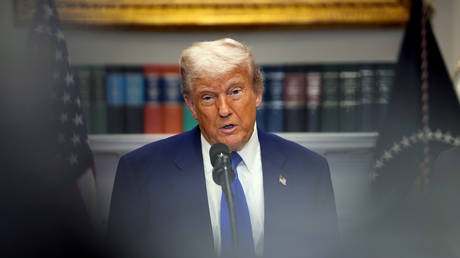 Trump ends tariff talks for most nations
Trump ends tariff talks for most nations
The DHS receives hundreds of TV show proposals every year and each of them “undergoes a thorough vetting process prior to denial or approval,” the assistant secretary said. The pitch for ‘The American’ “has not received approval or denial by staff,” she added.
The pitch reportedly says: “contestants will represent a wide demographic of ages, ethnicities, and talents. We will join in the laughter, tears, frustration and joy – hearing their backstories – as we are reminded of how amazing it is to be American, through the eyes of 12 wonderful people, who want nothing more than to have what we have – and what we often take for granted: the freedom, opportunity and honor of what it means to be American.”
Worsoff, who immigrated to the US from Canada, told the Wall Street Journal on Friday that none of the losers in the show would be penalized or face deportation. “This is not ‘The Hunger Games’ for immigrants,” he said.
READ MORE: US to pay illegal migrants to leave
In an interview with CNN, Worsoff noted that he first pitched the idea for the series to the DHS during the administration of US President Barack Obama. He added that he recently held three meetings with DHS officials regarding the show. “I feel like we are trending in a good way,” he said.
-
Site: Catholic ConclaveFor the opening of "775 - WESTFALEN. The exhibition" and the ceremony to mark the anniversary year "1250 years of Westphalia" which was broadcast live from Paderborn Cathedral on Thursday, 15 May 2025 at 6 pm.Federal President Frank-Walter Steinmeier and the Minister President of North Rhine-Westphalia, Hendrik Wüst MdL, will take part in the ceremony. Archbishop Bentz was also Catholic Conclavehttp://www.blogger.com/profile/06227218883606585321noreply@blogger.com0
-
Site: Real Investment Advice
Inside This Week's Bull Bear Report
- Recession Probabilities Decline
- How We Are Trading It
- Research Report - Do Stock Buybacks Move The Market?
- YouTube - Before The Bell
- Market Statistics
- Stock Screens
- Portfolio Trades This Week
The "Can't Stop, Won't Stop" Rally
Last week, we discussed how the rally had repaired much of the previous damage following "Liberation Day." However, we also made competing cases for the bulls and bears on the market's next move.
"It is always difficult to say whether this is a 'bear market' rally while you are in the midst of it. In hindsight, these things are easy to identify, and investors have plenty of reasons to play the 'could've, should've' game. However, some valid arguments exist about why the recent correction was just that, and may now be over."
This past week, the market continued its advance. There is little reason to be bearish with key overhead resistance levels broken. However, as shown, the markets are reaching decently overbought levels after being extremely oversold. This suggests that at least for now, the "easy money" has been made. With the market above the 200, and above the 50 and 20-DMA, pullbacks should be between 5600 and 5800. Investors can use such a pullback to increase portfolio equity exposures and reduce hedges accordingly. Conversely, 5000 to 5200 becomes the next critical target if those lower supports are violated. However, such would require some unexpected event to unfold.

Given the reduction in tariff-related risk and stable economic data, we suspect the market will hold bullish support. That statement follows our analysis from earlier this week, which discussed whether we have returned to a bull market or if this is still a bear market rally. That analysis compared the current market advance to the 2022 corrective cycle. However, that article elicited quite a few comments about why the recent "tariff" sell-off could be like the 2020 COVID-pandemic decline and recovery. It's a fair question and worth a few words.
2020 vs 2025
As shown, there is an analogy between the current market recovery and that seen in 2020 following the pandemic. However, it is worth remembering that there are many competing differences between the current macroeconomic backdrop and that of 2020.

However, as we discussed in that previous analysis, even a "can't stop, won't stop bull market" gives those who can be patient better risk/reward opportunities to increase equity exposures. For example, after the initial rally off the March 2020 lows, the market pulled back and consolidated briefly before rallying further. Then, another longer consolidation process that year provided another entry point for bullish investors.

The weekly Technical Gauge we produce each week in this newsletter below follows the same path as 2020. While not yet back to bullish technical extremes, it is moving quickly higher to more elevated levels. When those readings reached 80, the market went through a longer consolidation process in 2020.

So, is this 2022 where the recent rally will fail and test lower levels? Maybe. Or, is it more like 2020, where the rally continues with only mild pullbacks along the way? Possibly. The true answer is that I don't know. However, it is worth considering that there are many macroeconomic differences today compared to 2020. That lack of fiscal and monetary support, slowing economic growth, and tighter monetary policy are headwinds to higher stock prices. But, it is logical that the latest bullish market action has investors questioning a more cautious approach to the markets.
The same is true for us. We are currently underweight equities and hedged. However, the need for hedges is quickly declining, and the need for equity exposure is increasing. It's a tough battle between creating portfolio performance and risk management. We are sticking with risk management until things become more certain, at least for now.
This week, we will discuss why another bearish case is fading - recession probabilities are falling.
Need Help With Your Investing Strategy?
Are you looking for complete financial, insurance, and estate planning? Need a risk-managed portfolio management strategy to grow and protect your savings? Whatever your needs are, we are here to help.

A Funny Thing Happened On The Way To The Coliseum
“A Funny Thing Happened on the Way to the Coliseum” is a hysterical play by Craig Sodaro. In the play, Simplcuss, a naive Swiss farmer, heads for Rome to follow his dream of becoming a stand-up comedian; little does he know what adventures are in store. Stumbling into the house of General Spurius Sillius in search of food and water, he’s mistaken for the dreaded gladiator, Terribilus, who is due to fight in the Colosseum the following day. Simplcuss has to figure out how to save himself, and he overhears the General’s wife, Drusilla, and Senator Publius Piscious plotting to kill the Emperor’s daughter and the Emperor himself!
Without telling you the ending, there are many similarities to the current market. Over the last several months, the media headlines have been filled with stories of “Recessionus Terribulus." Whether President Trump planned to deport illegal immigrants, Elon Musk and DOGE cutting government spending, or lately the fears of tariffs, all played into the media headlines of an impending recession.

Of course, there was also economic data to help support those claims. As discussed in the "Consumer Is Tapping Out," rising delinquency rates are problematic. Particularly, for an economy driven by personal consumption. To wit:
"The current data point toward a recessionary risk. Deflation is highly correlated to economic growth rates, wages, and rates. Unsurprisingly, recessions reduce inflation as demand for goods and services collapses. While inflation may be “sticky,” the recent decline in bond yields and wages suggests consumer demand will decline this year. When tariffs, an additional tax on consumers, increase the cost burden, the reaction historically is not expansionary."

Furthermore, last weekend's #BullBearReport noted the rather sharp negative revisions to earnings estimates for the S&P 500 index.
"Given the slowdown in economic growth rates, it is unsurprising that, as of May 1st, S&P Global finally acquiesced and revised earnings estimates lower. However, this wasn’t a mild earnings revision but a slashing of estimates from their April 15th expectation of $292/share in 2026 to just $274. Furthermore, full-year 2025 reported earnings estimates were cut by nearly $20/share from $258/share to just $238/share."

However, what is interesting is that despite these and several other indicators suggesting an increase in recessionary risk, the financial markets are currently putting in one of the strongest rallies we have seen since the COVID pandemic. Of course, much of that rally came on the heels of the relief of the sharp reduction of tariffs on China, one of the U.S.'s key trading partners.
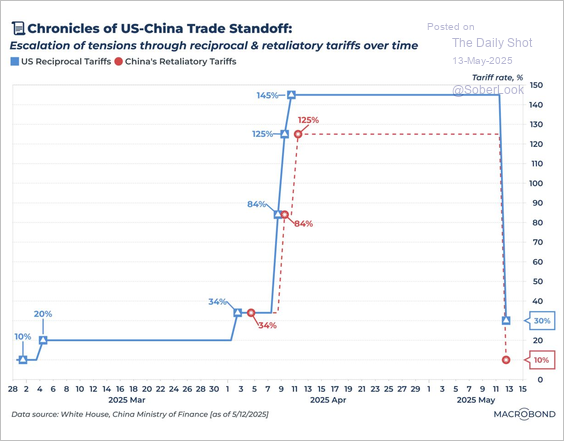
As such, while Wall Street analysts and economists were slashing economic growth and earnings estimates just a month ago, striking fear into investors' hearts, that has now reversed.
Recession Probabilities Are Falling
Following the announcements of trade deals with both the UK and China, recession probabilities for 2025 declined. Now, economists are rushing to reverse those previous recession calls.

The reality is that the onerous tariff levels initiated by the Trump administration were never permanent. This was a mistaken assumption by the mainstream media. Furthermore, the "inflation impact" from tariffs, which was expected to cause the recession, has yet to appear. Such is evident in both inflation reports this past week. The chart below shows the composite CPI/PPI index and whether inflation is above or below the long-term average inflation rate. Currently, inflation is 2% below its long-term average.

Inflation failing to appear is unsurprising and something we discussed in detail in "Tariffs Roil Markets." In their rush to undermine the current administration, the media also failed to consider two important facts we discussed previously.
"The first is that Trump’s tariffs are a 'stick and carrot' for negotiating an agreement with both Mexico and Canada. As you will see, all he wanted was assistance in securing the borders, reducing illegal immigration, and arresting the illegal flow of drugs, especially “Fentanyl,” into the U.S. Therefore, any assistance provided by Canada or Mexico would lead to a reversal of those tariffs. Secondly, we stated the market’s opening would likely be the worst level of the day, so any “panic selling” of positions early in the morning would likely be a mistake."
That same logic applies to China and every other country dependent on U.S. trade. Given that China depends on roughly $50 billion in annual trade (16.2% of total exports worldwide) to the U.S. for its economic growth, President Trump was correct in assuming he had a stronger hand in the negotiations.

With those tariffs vastly reduced, the risk of the recessionary impact from an excess "tax" on consumers is fading. However, even with the tariffs reversed, the economic data, while slowing, does not suggest that a recession risk is imminent.
A Recession-Proof Economy?
Doug Cass made a valid point this past week, asking if the "economy is now recession-proof."
"Is the economy now recession-proof? Is this also now a syntax question as opposed to a practical question?
By a syntax question, this is what I mean. Recession is measured by reported GDP and reported employment. GDP is in part a function of reported inflation. If inflation is understated, GDP is overstated by the same amount. Employment includes jobs going to immigrants, second jobs, jobs created by the birth/death model, and jobs going to government employees that often have negative productivity and whose roles (regulatory and bureaucratic nonsense) end up harming the country and the economy, even though they help GDP in the short term.
The country thought we were in recession in the middle part of the Biden term. This includes very prominent financial minds and the average Joe. There is a reason the election went the way it did: “It’s the economy, stupid.” But, as measured by the official stats, there was no recession, and things were pretty good. Now, we are still not in recession, and as measured by the same stats, it still seems 50% likely we will not be in recession, and if we ever enter one, it feels like it might be mild, at least as measured by those same statistics.
So, is the economy now recession-proof? If we don’t go into a recession now, with the shaky foundation that was in place, including an overspent consumer, all the debt, global tensions, and all the uncertainty, it feels like we will never have a recession."
It seems that way, but the one contributing factor that broke all pre-existing models was the flood of monetary and fiscal stimulus post the COVID pandemic. It may take us years to determine if the previous historical models and indicators, such as inverted yield curves, ever function as they did previously to gauge recession probabilities. Maybe they won't.
However, as noted above, economists are rapidly reversing their predictions about the recession and now suggest that President Trump's actions, while previously thought to be an economic disaster, might be beneficial. Furthermore, financial conditions are improving, which also supports economic activity. If that trend continues, particularly if the Fed resumes cutting interest rates, it should start to feed into consumer confidence. If consumer confidence strengthens, which would be logical following recent tariff resolutions, this should reduce recession probabilities further.

Understand the message here. As discussed two weeks ago, the economic growth rate is slowing, but recession probabilities remain low.
That does not mean that a recession is permanently avoided.
However, therein lies the problem with recession probabilities and predictions in the first place.
The Problem With Recession Predictions
It is wise to remember that in 2022, we had the most anticipated recession, which failed to occur and preceded one of the strongest bull markets in recent history.
The problem with predicting recessions is that economists always work off lagging economic data. Such is particularly the case with GDP, which is revised three times following the end of the quarter, 12 months, and 3 years later. Historically, given that lag, the timing of U.S. recessions can be off by 9 to 12 months before they are recognized by the National Bureau of Economic Research (NBER). The chart below shows the lag between the onset and recognition of previous U.S. recessions.

The following table better shows the lag between the start and recognition of previous U.S. recessions. I have also noted the impact on financial markets as investors reprice earnings growth for a reversal in economic growth rates.

Investors must decide whether the current correction is “just a correction” or whether the risk of a U.S. recession is increasing.
Currently, few indicators suggest recession probabilities are rising. The Economic Composite Index (a comprehensive measure of economic activity comprised of more than 100 data points) is in expansionary territory. The EOCI index confirms the improvement in the 6-month rate of change in the Leading Economic Index (LEI), one of the best recession indicators, and current levels of economic growth. While economic growth will undoubtedly slow as all of the excess governmental spending under the previous Administration reverses, there is currently no recession warning in the data. That does not mean that it can not change in the future. However, for now, the risk of recession is extremely low.

Adding to that analysis, the economically weighted ISM composite index is also in expansionary territory, suggesting no current risk of recession. This composite index (80% service / 20% manufacturing) is why we wrote that there was no recession risk in 2023 or 2024 despite inverted yield curves.

Lastly, Government spending remains robust, which fuels economic growth. While the current Administration is looking to cut spending and reduce the deficit, which would weaken economic growth rates, they are making very little headway.

Furthermore, despite the hopes that DOGE would cut Federal spending, it has only returned to the post-financial crisis exponential growth trend as the Government continues to use “Continuing Resolutions” to fund the Government. These resolutions automatically increase government spending by 8% annually. In other words, spending doubles every nine years, so debt levels continue to rise, feeding into economic growth rates.

Conclusion: Staying Grounded Amid Market Volatility
While recession probabilities have resurfaced in the headlines following the recent market sell-off, the economic data does not yet support the narrative of an imminent downturn.
As I discussed in “The Risk Of Recession Is Not Zero,” the government is currently engaged in activities that will impact economic growth. If those actions are combined with those of an already struggling consumer, the risk of recession will undoubtedly increase. Thus, economists are now scrambling to reverse their recession calls.
Historically, recession calls tend to be premature, often relying on lagging indicators that confirm economic contractions only well after they have begun. Current indicators point to a slower economic expansion, not contraction. Although growth is slowing, a slower growth environment does not equate to a recession—a distinction investors must keep in mind.
The more significant concern for markets is the inevitable impact of slowing economic growth on corporate earnings expectations. With analysts projecting continued double-digit earnings growth into 2026, there is an apparent disconnect between these forecasts and the economic reality. History suggests that earnings will eventually revert to levels that align with economic activity, which could lead to further bouts of market volatility.
For investors, the key takeaway is to stay informed, focus on fundamentals, and avoid being swayed by short-term noise. While volatility and corrections are natural in market cycles, history shows that panic-driven decisions often lead to missed opportunities. As long as economic indicators remain expansionary, the risk of a recession remains low, though careful monitoring is warranted. Investors should continue to assess their portfolios, manage risk prudently, and position themselves for a gradual slowdown rather than an economic collapse.
How We Are Trading It
As noted last week, we continue to manage our portfolios in a manner that allows us to participate in the market while still hedging against underlying risk. As such, we have started rebalancing risk as necessary and adjusting portfolio holdings to improve relative market performance. Notably, the breadth of the market has improved, but as noted above, the short-term overbought conditions suggest the "easy money" has been made. We will wait for corrections to reduce cash balances further and remove portfolio hedges entirely. That is, of course, unless some other unexpected event surfaces that substantially increases market risk.
As noted, while the risk of recession has fallen, recession probabilities are not zero. As we said in Friday's Daily Market Commentary:
"However, patience will likely pay off here. As noted previously, we are still on a weekly sell signal, which has historically led to short-term market underperformance. As shown, previous periods of historical weekly moving average crossovers typically involve a more extended period of consolidation or corrective price actions. The main exception to that rule was 2020, when the Federal Reserve intervened with massive monetary support. With yields rising and the Fed on hold, no excess support is coming into the market other than a surge in corporate buybacks. However, those are due to decline starting next month."

Continue to follow the rules and stick to your discipline. (Read our article on “What Is Risk” for a complete list of rules)
Have a great weekend.
(Note: The allocation below contains a 5% short S&P 500 position in the ETF allocation.)

Feel free to reach out if you want to navigate these uncertain waters with expert guidance. Our team specializes in helping clients make informed decisions in today’s volatile markets.
Research Report

Subscribe To “Before The Bell” For Daily Trading Updates
We have set up a separate channel JUST for our short daily market updates. Please subscribe to THIS CHANNEL to receive daily notifications before the market opens.
Click Here And Then Click The SUBSCRIBE Button
Subscribe To Our YouTube Channel To Get Notified Of All Our Videos
Bull Bear Report Market Statistics & Screens

SimpleVisor Top & Bottom Performers By Sector

S&P 500 Weekly Tear Sheet

Relative Performance Analysis
Unsurprisingly, after the pervasive rally over the past week, almost every major market and sector is now extremely overbought. With recession probabilities falling sharply, the rush to regain equity exposure has forced ongoing short-covering. However, it is unlikely the market will be able to push much further without a short-term correction or consolidation to relieve some of that overbought condition. Take some profits, rebalance risks, and look for a pullback to reduce hedges and add exposures.

Technical Composite
The technical overbought/sold gauge comprises several price indicators (R.S.I., Williams %R, etc.), measured using “weekly” closing price data. Readings above “80” are considered overbought, and below “20” are oversold. The market peaks when those readings are 80 or above, suggesting prudent profit-taking and risk management. The best buying opportunities exist when those readings are 20 or below.
The current reading is 69.06 out of a possible 100.

Portfolio Positioning “Fear / Greed” Gauge
The “Fear/Greed” gauge is how individual and professional investors are “positioning” themselves in the market based on their equity exposure. From a contrarian position, the higher the allocation to equities, the more likely the market is to be closer to a correction than not. The gauge uses weekly closing data.
NOTE: The Fear/Greed Index measures risk from 0 to 100. It is a rarity that it reaches levels above 90.
The current reading is 69.35 out of a possible 100.

Relative Sector Analysis

Most Oversold Sector Analysis

Sector Model Analysis & Risk Ranges
How To Read This Table
- The table compares the relative performance of each sector and market to the S&P 500 index.
- “MA XVER” (Moving Average Crossover) is determined by the short-term weekly moving average crossing positively or negatively with the long-term weekly moving average.
- The risk range is a function of the month-end closing price and the “beta” of the sector or market. (Ranges reset on the 1st of each month)
- The table shows the price deviation above and below the weekly moving averages.
The "relentless rally" continued this past week and has pushed most markets and sectors well above their normal risk ranges. That rally in equities has come at the expense of gold, gold miners, and bonds, which we previously warned would be the case. However, given the more extreme short-term overbought conditions, investors should look for a correction over the next week or two to relieve some of that pressure. However, that dip should likely be bought particularly if supports hold at the 200-DMA.

Weekly SimpleVisor Stock Screens
We provide three stock screens each week from SimpleVisor.
This week, we are searching for the Top 20:
- Relative Strength Stocks
- Momentum Stocks
- Technical Strength W/ Dividends
(Click Images To Enlarge)
RSI Screen

Momentum Screen

Technically Strong With Dividends

SimpleVisor Portfolio Changes
We post all of our portfolio changes as they occur at SimpleVisor:
May 15th
This morning, we took some profits in our energy positions, coinciding with the crude oil price bump. Our concern is that oil prices will head back lower due to “drill baby drill” policies, OPEC policies, and a weakening economy. While we reduced the total energy exposure, we did add to OKE (up to 2%), as it is a natural gas pipeline company and less impacted by lower crude prices. We added a 1% position in AMLP, an ETF holding pipeline stocks. It pays a nearly 8% dividend. While we prefer OKE, it does help align the exposure in the sector model more closely with the equity model.
Equity Model
- Sell 100% of XOM and FANG
- Increase OKE to 2% of the portfolio.
ETF Model
- Sell 100% of iShares Energy ETF (XLE)
- Add 1% of the portfolio to AMLP
May 16th
In early April, we reduced our exposure to healthcare stocks as the threat of tariffs loomed large. With that threat largely mitigated, and the recent executive order on drug pricing being more “bark than bite,” we are starting to rebuild our positions at better prices. Today, we are increasing our current exposure in AbbVie (ABBV) and Eli Lilly (LLY) in the equity model, and adding to the iShares Healthcare Sector (XLV) in the ETF model.
Equity Model
- Increase ABBV to 3.5% of the portfolio and LLY to 2.5%.
ETF Model
- Increase XLV to 7% of the portfolio.
Lance Roberts, C.I.O., RIA Advisors
The post Recession Probabilities Decline appeared first on RIA.
-
Site: RT - News
The reduction comes shortly after the Treasury secretary warned of a possible default by the end of summer
Moody’s has stripped the US of its perfect triple-A credit rating, citing increasing concerns over debt affordability. The rating agency had held the country’s sovereign credit rating at the highest possible level since 1917.
The move brings the 116-year-old agency into line with its global rivals. Fitch Ratings downgraded the US rating to AA+ from AAA in August 2023, and Standard & Poor’s cut it to AA+ from AAA in August 2011.
The reduction to Aa1 “reflects the increase over more than a decade in government debt and interest payment ratios to levels that are significantly higher than similarly rated sovereigns,” Moody’s said in a statement released on Friday.
The agency noted that successive US administrations and Congress have failed to reach an agreement on measures to reverse the pattern of large annual fiscal deficits and rising interest costs.
Moody’s stated, however, that the US retains exceptional credit strengths, citing its size, resilience, dynamism, and the role of the dollar as the global reserve currency.
Earlier this month, Treasury Secretary Scott Bessent warned about the possibility of a default as soon as August, calling for either raising or suspending the debt ceiling – a statutory limit on how much the federal government can borrow – to avoid running out of money to cover federal expenses.
Read more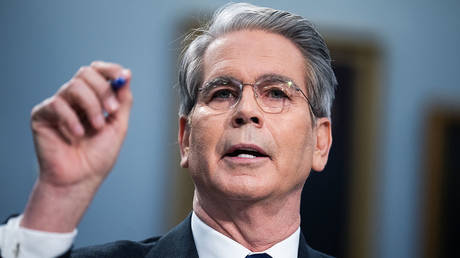 US could face default by August – Treasury chief
US could face default by August – Treasury chief
The US reached its ceiling of $36.1 trillion in January. Once the limit is hit, the government is legally barred from borrowing further to meet its obligations. The total federal debt has climbed to $36.2 trillion, according to official figures.
The Treasury has avoided default by using so-called “extraordinary measures” – mainly accounting maneuvers such as suspending contributions to federal employee retirement funds – to keep up with its financial commitments.
Under former President Joe Biden, the debt ceiling was raised three times. The current president, Donald Trump, has argued that the cap should be eliminated entirely, calling it pointless if it’s routinely lifted. He has argued that the concept of a debt ceiling “doesn’t mean anything, except psychologically.”
Commenting on the rating downgrade, White House spokesperson Kush Desai said on Friday that Moody’s “would not have stayed silent as the fiscal disaster of the past four years unfolded” if the agency “had any credibility.” He also claimed that the Trump administration is currently dealing with the “mess” left by the previous administration.
-
Site: Catholic ConclaveBecause, as Perón said, "we are all Peronists," and, as Bergoglio said, "every person is a child of God."Perón and Bergoglio's greatest enemies were the same conservative military officers and cardinals who had given them the opportunity to govern.As often happens with deaths, I inevitably thought of Pope Francis, a person who hadn't interested me much while he was alive. For those of us who are Catholic Conclavehttp://www.blogger.com/profile/06227218883606585321noreply@blogger.com0
-
Site: Crisis Magazine

There have been so many dark centuries in the history of Christendom that one hesitates to call any particular century the darkest of all. Some have been as dark as the 20th century, but none have been as deadly. In terms of the sheer body count, the 20th century, with its wars of irreligion and its access to industrialized weapons of mass destruction, is the most murderous in human history.
-
Site: RT - News
European NATO members have no idea whether the US president is ready to be tough on Russia, the outlet claims
European NATO members are “frustrated” with US President Donald Trump’s “constant swerving” on Ukraine peace talks, which they believe undermines their ability to pressure Russia, Bloomberg reported on Friday, citing sources.
Kiev’s backers are uncertain regarding what Trump will do following the inconclusive Turkish-mediated talks between Russia and Ukraine in Istanbul on Friday, according to the news agency. The meeting was the first direct engagement between the belligerents since 2022.
Key European NATO members initially believed that Trump supported their plan to impose new sanctions on Russia if it rejected the demand for a 30-day unconditional ceasefire with Ukraine, the article said. Moscow has stated that it is open to a ceasefire “in general,” but has expressed concern that it would only give Ukraine time to regroup and rest its battered forces.
Read more Russia ready for ‘possible compromises’ – Putin aide
Russia ready for ‘possible compromises’ – Putin aide
However, the West’s unified front apparently started to crumble after Moscow proposed direct Russia-Ukraine talks in Istanbul without any preconditions, according to Bloomberg. The overture prompted the US president to insist that Kiev “immediately” agree to restart dialogue, despite Vladimir Zelensky’s reluctance to do so without a ceasefire.
One European official expressed hope that the Istanbul meeting would “make it clear to Trump that the Russians aren’t serious about peace talks,” prompting the US to respond decisively. Some European leaders reportedly believe that Trump may still follow through on earlier threats to impose secondary sanctions and banking restrictions on Moscow.
Others, however, are said to be skeptical about whether Trump – who has repeatedly said he wants to meet with Russian President Vladimir Putin to settle the Ukraine conflict – has an appetite for drastic measures.
At the Istanbul meeting, discussions included ceasefire options, a prisoner exchange, and plans for a potential follow-up meeting. Vladimir Medinsky, Russia’s top negotiator, said Moscow is “satisfied” with the results of the Istanbul talks and is ready to “resume contacts” with Kiev.
Russia has stated that the Ukraine conflict could be settled if Kiev commits to permanent neutrality, demilitarization, denazification, and recognizes the “territorial reality on the ground.” Kiev, however, has ruled out any territorial concessions to Moscow.
-
Site: Catholic ConclaveFoyers de Charité: 200 "victims or problems" out of 1,000 members?Natalia Trouiller, a former journalist at La Vie and former communications manager for the Diocese of Lyon, who has become a specialist in supporting victims of sexual violence in the Church, focuses in a thread on yet another community emerging from the French Charismatic Renewal and plagued by problems of control, mystical fraud,Catholic Conclavehttp://www.blogger.com/profile/06227218883606585321noreply@blogger.com0
-
Site: AsiaNews.itToday's news: Indian authorities abandoned 40 Rohingya at sea after being detained in New Dheli. In South Korea, former President Yoon leaves the PPP in an attempt to help candidate Kim Moon-soo back in the polls. The Indonesian navy seized a ship with $425 million worth of methamphetamine and cocaine. No truce and agreement on hostages from Ukraine and Russia's meeting in Istanbul
-
Site: Catholic ConclaveBlessing Gives Strength to LoveBlessings for Couples Who Love Each OtherHandbook for PastorsIn front of Cologne CathedralResolution Text of the Joint Conference of April 4, 2025"The Church wishes to proclaim the message of the God-given dignity of every person in word and deed. This message guides her dealings with people and their partnerships. Therefore, she recognizes and offers support to Catholic Conclavehttp://www.blogger.com/profile/06227218883606585321noreply@blogger.com0
-
Site: AsiaNews.itAs the parodies of peace negotiations between Russia, Ukraine and America continue—most recently marked by the failed attempt to bring Putin and Zelenskyy together in Istanbul—Pope Leo XIV has directed an appeal to the Christians of the East:'Who more than you can sing words of hope in the abyss of violence'
-
Site: Mises InstituteIs the Federal Reserve truly independent? Jonathan Newman uncovers the myths behind the 1951 Treasury-Fed Accord.
-
Site: Mises InstituteRon Unz critically reassesses the established narrative of World War II.
-
Site: Mises InstituteWith the resurrection of Saudi Arabia's Jeddah Tower project set for completion around 2027, could another global economic crisis be imminent?
-
Site: The Unz ReviewEarlier this year a group of patriots peacefully marched in Adelaide singing Waltzing Matilda on Australia Day – only to be shut down and arrested by the police. On the same day, there was an anti-Australia, antiwhite rally being held with chants of “Death to Australia” deemed perfectly legal. The march made national news but...
-
Site: The Unz ReviewIn the outcome, it’s the old story come true again. That’s the one in which Tarquin, the ancient Roman king, wanted the Cumaean Sybil to sell him the nine books of prophecies known as the Sybilline Oracles. When the king dismissed the Sybil’s price for the nine, she burned three and asked the same price...
-
Site: The Unz ReviewDespite ferocious opposition from politicians, antifa, and the media, the first European Remigration Summit — ReSum25 — was a smashing success. Speakers included some of the biggest names in European nationalism, and the audience of some 300 people was overwhelmingly young, enthusiastic, and by all appearances, deeply committed to the cause of our people and...
-
Site: RT - News
France is attempting to undermine the will of the voters, George Simion has said
France has been trying to subvert democracy in Romania, Euroskeptic presidential candidate George Simion has said ahead of Sunday’s runoff vote.
Simion, a critic of the EU who has been banned from entering Ukraine, won the first round of the presidential election rerun on May 4 with more than 40% of the vote.
The rerun was held after Romania’s Constitutional Court annulled the results of a vote held in November, in which independent right-wing candidate Calin Georgescu came first with 23%.
The authorities cited “irregularities” in his campaign, as well as intelligence reports alleging Russian interference in the election – claims Moscow has strongly denied. Simion, the leader of the right-wing Alliance for the Union of Romanians, has backed Georgescu and said he could appoint him prime minister if elected.
In an interview published on Friday, entrepreneur Mario Nawfal asked Simion if he had received “indirect or direct threats” from abroad. Simion alleged that Paris was working behind the scenes to pressure Romania’s top court, media regulator, and businesses.
“They are putting a lot of money and pressure – through their ambassador here, and through foreign institutions – in order to rob the Romanian people of their vote,” he said.
Read more Romanian PM resigns after anti-EU nationalist takes election lead
Romanian PM resigns after anti-EU nationalist takes election lead
Simion drew a parallel with the recent decision by a French court to bar veteran conservative politician Marine Le Pen from the 2027 presidential election due to an embezzlement conviction.
“I want to address the free French people against this authoritarian [President] Emmanuel Macron, who doesn’t have the support of the French people, who banned Marine Le Pen, who is supporting the idea of imposing a dictatorship [in Romania] and canceling the will of the people,” Simion said.
He denounced the invalidation of the 2024 election results in Romania as a “coup d’état,” and claimed there were similar “evil plans” being made against him.
“The Romanian people were humiliated with the annulment of the election,” Simion said, vowing to resist foreign pressure. “We don’t have masters. The age of empires is over. We are free, sovereign nations. And these imperialistic reflexes Emmanuel Macron and others have will only backfire.”
The French ambassador to Bucharest, Nicolas Warnery, claimed that Romania experienced a “hybrid attack” in 2024. “We understand your decision to completely restart the presidential election from scratch,” he told Digi24 earlier this month.
-
Site: Zero HedgeNational Police Week: A Tribute To Our Law Enforcement HeroesTyler Durden Fri, 05/16/2025 - 23:30
Authored by Rep. Elise Stefanik via RealClearPolitics,
This National Police Week, we pause to honor the men and women who put their lives on the line every day to protect our communities. We remember the brave officers who made the ultimate sacrifice in the line of duty, and we express our deepest gratitude to those who continue to serve with unwavering dedication. It is an important moment to reflect on the courage, sacrifice, and selflessness that law enforcement officers demonstrate daily, particularly in Upstate New York and across our great state.
To the law enforcement officers of Upstate New York, the North Country, and everywhere else across our nation: Thank you. Your service does not go unnoticed, and your commitment to keeping our communities safe is deeply appreciated. I stand with you, and I will continue fighting for policies that prioritize the safety of our communities, ensuring that you have the resources and support needed to do your vital work.
In these challenging times, it’s crucial that we stand up for those who serve us. While the far left continues to push anti-police rhetoric and policies that put our officers in dangerous positions, it’s more important than ever to back the blue. The far-left “Defund the Police” movement and the dangerous rise of anti-police sentiment threaten the very fabric of our communities. Our law enforcement officers are the backbone of our safety and security, and they deserve the respect, resources, and protection to do their jobs effectively. Their hard work ensures that law-abiding citizens can live in peace, free from fear.
Unfortunately, many on the left in Albany, Washington, and across the nation are taking law enforcement for granted. Policies like reckless bail reforms and calls to defund the police only endanger our communities. It’s time we recognize the critical role our officers play in public safety and stop allowing radical left movements to jeopardize their ability to serve and protect.
During my tenure in Congress, I have worked tirelessly to provide officers with the resources, training, and recognition they deserve. I introduced bills aimed at bolstering funding for police departments, improving officer safety, and enhancing mental health services for law enforcement personnel. I also have been a vocal proponent of holding criminals accountable while ensuring that police officers have the necessary protections to do their jobs without fear of unjust retribution.
In Upstate New York, we are fortunate to have some of the most dedicated law enforcement officers in the country. Their work has resulted in our district having one of the lowest crime rates in the nation.
I’m proud to stand with them and will always fight for policies that support law enforcement and keep our communities safe.
National Police Week may only last seven days, but the gratitude and respect we owe to our men and women in blue should echo every single day. Thank you to our heroes in uniform, and may we continue to support and protect them in their mission to safeguard us all.
Republican Elise Stefanik represents New York’s 21st District in Congress.
-
Site: Zero HedgeRussian-Born Harvard Scientist Detained By US Charged With Smuggling Clawed Frog EmbryosTyler Durden Fri, 05/16/2025 - 22:30
Authored by Katabella Roberts via The Epoch Times (emphasis ours),
A Russian-born scientist and research associate at Harvard University has been arrested and charged with allegedly attempting to smuggle clawed frog embryos and embryonic samples into the United States, the U.S. Attorney’s Office for the District of Massachusetts announced on May 14.
 Kseniia Petrova, a Russian-born scientist who was a researcher at Harvard University, in April 2025. Polina Pugacheva via AP
Kseniia Petrova, a Russian-born scientist who was a researcher at Harvard University, in April 2025. Polina Pugacheva via AP
Kseniia Petrova, 31, was charged with one count of smuggling goods into the country.
If found guilty, she faces up to 20 years in prison, five years of supervised release, and a fine of up to $250,000.
The charges were announced just hours after a federal judge in Vermont heard arguments in a lawsuit Petrova filed against the Trump administration alleging she has been unlawfully detained at an immigration detention center in Louisiana for months.
She was transferred out of the custody of Immigration and Customs Enforcement (ICE) to a nearby Louisiana parish jail shortly after being charged.
An initial hearing in her criminal case has been set for May 15.
Petrova, a Russian national, was first taken into immigration custody on Feb. 16 after arriving at Logan International Airport in Boston following a trip to Paris.
According to prosecutors, she was stopped by Customs and Border Protection agents after her checked duffle bag was flagged for inspection, revealing biological items including a foam box containing clawed frog embryos in microcentrifuges, as well as embryonic samples in paraffin well stages and on mounted dyed slides.
Such biological products must be declared and require a permit to be brought into the country.
Prosecutors said that Petrova initially denied carrying such material in her baggage but acknowledged she had biological specimens when asked again.
She was then advised that she was ineligible for entry to the United States, at which point prosecutors say she agreed to willingly withdraw her application for admission, prosecutors said.
The Trump administration has indicated it plans to deport her back to Russia.
Lawyer Says Case Is ‘Meritless’
Petrova said she fled Russia after it invaded Ukraine in February 2022 to avoid conflict or possible political repression. She added that she fears she will be imprisoned if she returns because of her political views.
Her lawyer, Gregory Romanovsky, called the case against his client “meritless” and questioned the timing of the charges being announced, noting she was transferred into criminal custody after the judge in her lawsuit set a May 28 bail hearing to consider releasing her.
“The charge, filed three months after the alleged customs violation, is clearly intended to make Kseniia look like a criminal to justify their efforts to deport her,” he said.
During an interview under oath, Petrova allegedly claimed to be unsure that she was required to declare biological material when entering the country, prosecutors said.
However, prosecutors said text messages on her phone from an individual identified as one of her colleagues informed her that she was required to declare the biological material.
They alleged that in response to one text message asking how she planned to get through customs with the biological samples, Petrova said: “No plan yet. I won’t be able to swallow them.”
* * *
Support independent media. Grab a ZeroHedge hat at the ZH Store, or buy any 2 bags of coffee and receive a free ZeroHedge Tumbler!
Petrova’s case has drawn criticism from Democrats, including Massachusetts Attorney General Andrea Joy Campbell, who filed an amicus brief on May 12 opposing the government’s efforts to dismiss her petition for release.
The brief states that Petrova had been conducting critical research on degenerative diseases at Harvard under a valid J-1 visa prior to her detention 10 weeks ago.
“Ms. Petrova’s case is not an isolated incident—this is just the latest example of the Trump Administration’s reckless and cruel misuse of power to punish and terrorize non-citizen members of the academic community,” Campbell said. “I will continue to fight to defend the rights of our international students and faculty, who meaningfully contribute to the academic and economic success of our communities.”
The U.S. Attorney’s Office for the District of Massachusetts said Petrova was recently employed by the Institute of Genetic Biology in Moscow from 2023 to 2024 and previously served as a bioinformatician of genetic disorders at the Moscow Center for Genetics from 2016 to 2023.
Harvard University said in a statement that it “continues to monitor the situation.”
The Epoch Times has contacted Petrova’s attorney for further comment.
The Associated Press and Reuters contributed to this report.
-
Site: RT - News
The US president has once again called Vladimir Zelensky “the greatest salesman in the world”
US President Donald Trump has said he was concerned that billions of dollars were being wasted on aid to Ukraine.
In an interview aired on Friday, Fox News host Bret Baier asked Trump whether he believes Russian President Vladimir Putin is an “obstacle to peace” between Moscow and Kiev. Trump instead directed criticism at Ukrainian leader Vladimir Zelensky.
“I had a real rough session with Zelensky because I didn’t like what he said. He was not making it easy. And I always said he doesn’t have the cards,” the US president said.
He went on to slam the aid sent to Kiev by his predecessor, former President Joe Biden. “The money is the money. What bothered me – I hated to see the way it was, you know – excuse me – pissed away. I hated to see the cheques for $60 billion,” Trump said. “I think Zelensky is the greatest salesman in the world, far better than me. He comes to Washington – he walks out with a hundred million every time.”
“Congress is very upset about it. You know, they’re saying, where is all this money going?” Trump added. He went on to say, however, that Zelensky’s ability to lobby for American aid has been “shrinking” over time.
Read more Ukraine won’t survive a decade of conflict – Zelensky
Ukraine won’t survive a decade of conflict – Zelensky
The US has provided around $128 billion to Ukraine since 2022, including $66.5 billion in military assistance.
Although Trump has criticized both Zelensky and Putin in the past, he has mostly blamed Ukraine and the Biden administration for the ongoing conflict with Russia.
During a heated exchange in the Oval Office in February, Trump accused Zelensky of being ungrateful for US support and claimed the Ukrainian leader was “gambling with World War III.”
He has since softened his rhetoric toward Ukraine and has threatened to impose further sanctions on Moscow if no peace deal is reached.
Russia and Ukraine held their first direct talks in three years in Istanbul on Friday. The head of Russia’s negotiating team, Vladimir Medinsky, said the two sides had agreed upon a major prisoner swap involving 1,000 POWs from each side, as well as continuing contacts once each side has prepared a detailed ceasefire proposal.
-
Site: Zero HedgeHouse Considers Universal De Minimis Ban As Fees On China Parcels EaseTyler Durden Fri, 05/16/2025 - 22:00
By Eric Kulisch of FreightWaves
The Trump administration this week rolled back the duty for small-dollar shipments from China and Hong Kong as part of tariff deescalation with China, while a House committee advanced legislation to permanently end the duty-free “de minimis” exemption from all countries.
President Donald Trump’s executive order lowering new 145% tariffs on Chinese goods to 30% for 90 days represents a reprieve for popular Chinese shopping platforms and other e-tailers that ship parcels directly from the factory to individual shoppers. E-commerce orders and airfreight shipments plummeted after the U.S. government on May 2 rescinded duty-free treatment for low-value goods, subjecting them to the same duties imposed on all Chinese products.
Before then, U.S. trade law allowed an individual each day to import goods valued at $800 or less and use an informal entry process. The rule helped fuel cross-border shipping from Chinese shopping platforms direct to consumers. About two-thirds of all packages entering the country through the de minimis channel are from China.
The executive order also proactively lowered fees for low-value shipments from China sent through the international postal system. Postal shipments under $800 are now subject to a 54% tariff instead of 120%. Carriers can opt instead to pay $100 per postal item containing goods. Monday’s order canceled a June 1 increase to $200 for the flat fee.
The revised fees still present a significant cost increase, but the pause provides retailers time to adjust operations.
Logistics professionals say shipping rates could rise as businesses rush to order goods before the next deadline. Trade publication Modern Retail reported that fast-fashion retailer Shein on Wednesday announced price reductions for U.S. customers following the relaxation of de minimis rules on Chinese imports. Shein had raised prices and cut U.S. advertising after the change in de minimis rules sharply increased delivery costs.
The publication also said that Temu had resumed selling nondomestic items to U.S. customers.
Momentum builds to turn off de minimis
Congress a decade ago increased the de minimis ceiling from $200 to $800 as a way of helping small businesses with an online presence take advantage of international trade. But attitudes began to change when huge Chinese sellers like Temu, Shein and Alibaba flooded the trade facilitation program to minimize costs, putting a strain on U.S. Customs and Border Protection’s ability to cross-check shipments for trade, consumer safety or security compliance.
Critics say the exemption creates a conduit for criminals to smuggle goods with little scrutiny, gives overseas merchants an advantage over retailers that source domestic products and results in billions of dollars in uncollected tariff revenue.
CBP last year processed an average of more than 4 million de minimis imports per day but says the minimal information supplied on the informal entry makes it difficult to identify and interdict illegal drugs such as fentanyl, as well as counterfeit products and other contraband. It also has found cases of importers misclassifying and undervaluing goods, and misdelivering goods before they are officially released from CBP custody.
The U.S.-China Economic and Security Review Commission in December recommended that Congress eliminate de minimis eligibility for imports sold through online marketplaces.
On Tuesday, the House Ways and Means Committee approved a massive tax bill, which includes Trump’s tax priorities and a provision that would permanently end de minimis for commercial shipments from all countries by July 1, 2027.
“As the bill makes its way through the legislative process, we strongly support a more aggressive timeline to implement a permanent ban on de minimis globally given its significant harm to manufacturers, retailers, and the fight against fentanyl and other illegal products. Express shippers have already transitioned to processing all Chinese imports through sophisticated logistics systems, demonstrating their ability to comply with the president’s executive orders and pivot quickly,” said Kim Glas, president of the National Council of Textile Organizations, in a statement.
Meanwhile, other efforts are in progress to curb the use of de minimis entries.
Customs and Border Protection is developing a new rule, proposed in the waning days of the Biden administration, that would require certain shippers to electronically submit additional data elements on low-value consignments prior to arrival and would remove de minimis eligibility for imports subject to certain tariffs.
The White House has said it plans to use emergency powers to delete the de minimis exception once systems are in place to collect duties from millions of parcels per day, including ones sent through postal channels.
-
Site: Zero HedgeHow Legal Immigration Is Keeping Farms AfloatTyler Durden Fri, 05/16/2025 - 21:30
Authored by Darlene McCormick Sanchez via The Epoch Times (emphasis ours),
LAKE VILLAGE, Ark.—On a breezy day, sun and shadow dance across Mencer farms, turning it into a patchwork of green in the fertile Arkansas Delta.
It is humid here in the deep South, where the clock seems to run slower and the temperature hotter than in other places.
 Joe Mencer, owner of Mencer Farms in Lake Village, Ark., on April 29, 2025. Samira Bouaou/The Epoch Times
Joe Mencer, owner of Mencer Farms in Lake Village, Ark., on April 29, 2025. Samira Bouaou/The Epoch Times
Lake Village is a small town sitting along Lake Chicot, an abandoned channel of the Mississippi River. Over thousands of years, flooding deposited rich alluvial soil, making it ideal for crops such as rice, cotton, soybeans, and corn.
As a child, William Mencer’s grandfather handed him a cowboy hat and a garden hoe to dig up the pigweeds growing between the crop rows.
The 31-year-old farmer remembers spending long, sweltering days alongside the farmworkers, his hands growing rough and calloused with the effort.
“So I learned, you know, what it was like for these workers,” he told The Epoch Times.
He vowed to escape the sweat and toil of the fields by going to law school and working in an office. But the family farm drew him back like a love song.
Now he is partnering with his father, Joe Mencer, to keep the farm afloat with temporary agriculture workers through the H-2A visa program.
The fourth-generation family farm, which costs $4 million per year to operate, includes 6,000 acres that they own and lease.
While some may claim agriculture needs illegal immigrants to pick crops and work the fields, Joe Mencer told The Epoch Times that they’ve never had an illegal immigrant come looking for work.
They can’t get anyone local to work either, meaning that if they didn’t have the guest farm workers, they couldn’t stay in business.
What Is the H-2A Visa?
It costs more to bring in temporary legal workers than it would if they could find enough people locally to work. But without temporary migrant workers, William Mencer said local farms would go bust, affecting the nation’s food security.
The process has become much more complex since the Mencers began using the guest worker program back in the 1980s.
So much so that the younger Mencer started a small law practice helping other farmers obtain the labor they sorely needed.
He also shares his knowledge with other farmers as a member of the Arkansas Farm Bureau.
The process of hiring workers through the program, sometimes called a guest worker program, starts early in the year for the Mencer family.
 William Mencer, who works on his fourth-generation family farm, at Mencer Farms in Lake Village, Ark., on April 29, 2025. He partners with his father to keep the farm running with the help of temporary agricultural workers through the H-2A visa program. Samira Bouaou/The Epoch Times
William Mencer, who works on his fourth-generation family farm, at Mencer Farms in Lake Village, Ark., on April 29, 2025. He partners with his father to keep the farm running with the help of temporary agricultural workers through the H-2A visa program. Samira Bouaou/The Epoch Times
The paperwork needs to be filed 60 to 75 days before their start date, which is mid- to late-February, he said.
It costs as much as $5,000 to bring in several guest workers from Mexico to the United States, he said, noting that the cost doesn’t include the housing and transportation provided to the workers.
Most return home in mid-December, but they are eligible to stay for up to three years in certain situations when agricultural work is available.
The program requires the Mencers to advertise their farm jobs locally before they can be given to guest workers.
Joe Mencer, 65, noted that the rules call for him to fire any foreign worker he’s brought over if an American shows up and wants the job.
Tangled in Red Tape
The process to petition for workers with the U.S. Citizenship and Immigration Service is antiquated, with all communications taking place via mail, according to William Mencer.
The government does not offer online services, email, or a phone number. If there’s a problem, then the farm’s labor source is jeopardized because of the lack of communication, he said.
“Sometimes things get lost in the mail. You know, literally,” he said.
One of his client’s petition paperwork didn’t arrive in the mail. So they filed a claim for the lost package and resubmitted the paperwork.
This time, the paperwork made it to the Dallas office, but the postal carrier found the original package and shipped it, too.
With both petitions filed with the government, it almost took an act of Congress to clear it up.
The younger Mencer sent a letter explaining what happened with the evidence to the government officials, just like he would in court, but the office didn’t respond.
He enlisted the help of his congressman to clear things up. By the time it was all done, his client was behind by a month in getting guest workers.
It makes him wonder if the difficulty and red tape is “by design.”
 Joe Mencer, owner of Mencer Farms in Lake Village, Ark., on April 29, 2025. The Mencer family began using the H-2A visa program in the 1980s to bring in foreign workers. The program, often called the guest worker program, requires employers to first advertise farm jobs locally before hiring foreign labor. Samira Bouaou/The Epoch Times
Joe Mencer, owner of Mencer Farms in Lake Village, Ark., on April 29, 2025. The Mencer family began using the H-2A visa program in the 1980s to bring in foreign workers. The program, often called the guest worker program, requires employers to first advertise farm jobs locally before hiring foreign labor. Samira Bouaou/The Epoch Times
The workers are so important that the Mencers keep them busy even when the weather is bad, although it doesn’t help their bottom line.
When there’s no field work, they cut firewood for use in the winter months.
Joe Mencer said he realized a few years back that his son’s law degree would be helpful on the farm, especially given the increasing complexity of the H2A visa program.
Guest Worker Success
The Mencers said their farm couldn’t operate without H-2A visa workers, although the labor cost is higher than using local workers.
Farmers’ margins are already slim because of increased production costs for fertilizer, herbicides, seed, and fuel.
José Mondragon, who started as an H-2A visa worker, is now a green-card holder. He has worked for the Mencer family for nearly 30 years.
Others, such as Gabino Mondragon (no relation to José Mondragon) are H-2A visa holders who have only been working at the farm for a few years.
José Mondragon lives with his wife in a little house on the farm surrounded by flowers and trees. The 57-year-old has deep roots in the land, even serving as a pallbearer when Joe Mencer’s father passed away.
In late April, he operated a self-driving orange Case Magnum row crop tractor, which plowed the earth between the corn rows to improve irrigation.
José Mondragon said he’s seen American workers quit after two or three months, long before the crops are harvested in the fall. The lack of local workers can open the door for temporary visa workers, which is good for everyone, he said.
“The people [are] asking us if we have some opportunities to come with my boss, and we say we will ask him,” he said.
José Mondragon said some people come to the United States illegally because they get into trouble with the law back home or to escape the cartels. Others come to make more money to help support their families in their native countries.
Workers from Mexico make $14.83 per hour on the Mencer farm as legal workers, with the wage set by the government for each state.
 Green card holder Jose Delores Mondragon operates a tractor at Mencer Farms in Lake Village, Ark., on April 29, 2025.
Green card holder Jose Delores Mondragon operates a tractor at Mencer Farms in Lake Village, Ark., on April 29, 2025.
José Mondragon said human smugglers, known as coyotes, charge people big money to cross the southern border illegally.
Gabino Mondragon has been working at the Mencer farm on a guest visa for two years. He is experienced at running a spreader for nitrogen fertilizer for corn. One truckload of fertilizer can cost $20,000, according to William Mencer, so having a skilled operator is critical.
Gabino Mondragon believes that more people in Mexico would like to apply for an H-2A visa. Still, if they are caught coming into America illegally, they won’t be eligible unless they get a waiver. It would depend on their record.
The Mencers brought Gabino Mondragon’s family over on an H-4 visa so they could live close by while he worked.
The H-4 nonimmigrant visa allows the spouse and unmarried children younger than 21 years of age to accompany the primary visa holder to the United States.
It’s also an excellent opportunity for Gabino Mondragon’s family because his children are going to school and learning English.
“If our people are happy, it just reinforces that it’s a good thing for everybody,” William Mencer said.
Hanging by a Thread
The high cost of labor, diesel, and chemicals is making it extremely difficult for family farms to stay in business, according to William Mencer.
“We’ve been in four or five really bad years now,” he said.
Some farmers are faced with losing their farms to foreclosure by banks over crop production loans, finding a different line of work, or selling out.
Read the rest here...
-
Site: Zero HedgeFederal Contract Activity Slows As DOGE's Cost-Cutting Measures Take EffectTyler Durden Fri, 05/16/2025 - 21:00
President Donald Trump and Elon Musk's DOGE (Department of Government Efficiency) have exposed widespread federal waste and mismanagement that Congress long ignored. Despite the existence of oversight bodies like the Government Accountability Office, it took an executive order to uncover billions of dollars in egregious federal waste.
DOGE's drive to cut waste and root out fraud in the bloated federal bureaucracy has already resulted in nearly 300,000 job cuts and an estimated $160 billion in savings. As detailed in our series of reports, DOGE's actions are delivering tangible results—helping to reduce the nation's overall funding requirements.
The debt-fueled spending spree under the Biden-Harris regime placed the nation on a crash course to financial ruin—but recent corrective actions by the Trump administration and DOGE, for now, have helped steer the trajectory away from a financial crisis.
Readers may recall some of those tangible DOGE-related results:
-
US Treasury Unexpectedly Reports Sharp Drop In Debt Borrowing Needs, Rates Slide
-
US Treasury Shocks With Second Biggest Budget Surplus In History
-
Jobless Claims Jumped Last Week As 'DOGE Actions' Spark Biggest YTD Layoffs Since 2020
-
Is DOGE Starting To Work? 'Deep TriState' Jobless Claims Surged Last Week
Some progresshttps://t.co/hNCBVYB4YV
— Elon Musk (@elonmusk) April 11, 2025Everything outlined above points to a solid start for DOGE, which has already uncovered hundreds of billions in waste, fraud, and abuse. However, that progress could be undone unless Congress moves to lock in those spending cuts through the reconciliation bill.
DOGE has identified hundreds of billions of dollars of waste, fraud, and abuse, but unless Congress makes those spending cuts permanent through the reconciliation process, all that work will have been for nothing.@Paul_S_Mullen pic.twitter.com/7Y8j4T5ehJ
— Heritage Foundation (@Heritage) May 5, 2025Another measure of DOGE's early success is the 20.5% reduction in non-defense federal obligations compared to 2024 levels—a decline that signals reduced future cash outlays as these obligations come due.
"Persistent government-wide contract reviews for wasteful spend, consistent with the DOGE Cost Efficiency Executive Order, are bearing fruit," DOGE's official X account wrote.
Adding to the visible signs of progress, Goldman chief economist Jan Hatzius, along with analysts Alec Phillips and others, noted Thursday that cash withdrawals from the Treasury General Account across several federal agencies continue to fall below 2023 and 2024 levels—yet another encouraging sign of success.
Also, new monthly federal contract obligations have sharply slowed under DOGE after four years of large spikes under the Biden-Harris regime.
"Notably, new federal contracts data has undershot trend in recent months and stood at $18.2bn in April (compared to $31.1bn in April 2024). Total government grant awards remain stagnated at Inauguration Day levels," the analysts said.
More color here.
However, Hatzius and his team noted that year-to-date cash withdrawals from the Treasury General Account remain $123 billion above 2024 levels.
The early results of DOGE mark a shift in federal accountability. In just months, DOGE has uncovered hundreds of billions in waste, slashed nearly 300,000 federal jobs, and driven $160 billion in savings. Yet why did it take an executive order from the president to have a group take a deep dive into how federal agencies spend their money?
But this progress is not guaranteed. Without congressional action to lock in these cuts through reconciliation, the swamp remains open for the bureaucratic bloat to return. The message is clear: DOGE is working, but can only be sustained through political action.
-
Site: Zero HedgeJordan's King Warned US Against Assassinating Syria's Sharaa Before Trump MeetingTyler Durden Fri, 05/16/2025 - 20:30
Jordan’s King Abdullah II warned the US against assassinating President Ahmed al-Sharaa before the new Syrian leader met with President Donald Trump, a US senator said on Thursday.
The remarkable statement by a US senator reveals the deep hostility toward Sharaa in some circles of the Trump administration. It reaffirms Trump's own statements that he has been lobbied directly by foreign leaders to give Sharaa a chance, while his own advisors are skeptical.
"I have been concerned by some rumors that I have heard in…some foreign policy circles of the administration that one option that’s been suggested is assassinating the new leader of the Syrian government, Ahmed al-Sharaa," Democratic Senator Jeanne Shaheen said in a Senate hearing on Thursday.
 US Senator Jeanne Shaheen, via AP
US Senator Jeanne Shaheen, via AP
According to Shaheen, Jordan’s King Abdullah II heard about the alleged discussions to assassinate Sharaa and warned against it.
“One of the things that was pointed out to us by King Abdullah was that a change in leadership of that kind would create an all-out civil war in Syria. That would not be good to take advantage of the opportunity we have to move that country forward,” Shaheen said.
Shaheen met with King Abdullah in Washington, DC, in May, suggesting that those discussions may have taken place just before Trump cancelled sanctions on Syria and met Sharaa. Shaheen made the remarks during her questioning of Joel Rayburn, Trump’s nominee for undersecretary of state for the Near East, the top Middle East position in the State Department.
The admission by Shaheen is remarkable, given the events of this week. Trump surprised his own senior officials and Israel by announcing he was lifting all sanctions on Syria. Trump then held a meeting with Sharaa in Riyadh on Wednesday.
Speaking to reporters on Air Force One after the meeting, Trump showered praise on Sharaa, saying he was a “young, attractive guy. Tough guy. Strong past. Very strong past. Fighter”.
Asked to comment on the assassination "option", Rayburn replied, “I’m not familiar with efforts like that, but that's clearly not in line with the president's intention…or his description of Sharaa in the past couple of days.”
Blindsided
Trump’s decision to remove all US sanctions on Syria, going back to 1979, was met with thunderous applause in Riyadh, but has annoyed members of the US government. Some in the US State Department who have advocated for sanctions relief also felt sidelined.
It must have been a tense meeting yesterday in Damascus between HTS chief Jolani and the head of Iraqi intelligence. Especially for the Iraqi delegation a hard pill to swallow as Jolani before his time in Syria was in Iraq with Zarqawi blowing up Iraqis. pic.twitter.com/mojl2jTmEd
— Jenan Moussa (@jenanmoussa) December 27, 2024Just a few days before the announcement, the State Department’s Syrian advisors were briefing foreign counterparts that the Trump administration was set to keep sanctions on the new government in Damascus, one regional official told Middle East Eye.
Meanwhile, hardline members of Trump’s National Security Council have told counterparts privately that they would try to drag out the sanctions relief process to obtain concessions from Sharaa, one current and one former US official told MEE.
Democratic Senator Chris Murphy warned on Thursday about members of Trump’s administration working to “undermine” his decision. Rayburn’s hearing was notable because he was seen as hard line on Syria when he served as envoy to the country during Trump’s first term in office.
“I support the President’s goals and his initiative as he laid out,” Rayburn said. “It offers a golden opportunity to turn the page…the president is taking a bold move…he has expectations.”
The White House says it wants Sharaa to expel Palestinian fighters and foreign fighters from Syria, and combat the Islamic State militant group. Trump also said he discussed Syria normalizing ties with Israel. "I told him, 'I hope you’re going to join when it’s straightened out.’ He said, ‘Yes.’ But they have a lot of work to do," Trump said, according to a White House pool report.
Sharaa was the commander of Hayat Tahrir al-Sham or HTS, an Islamist group which toppled the decades-long Assad dynasty in December 2024. Sharaa participated in the Iraq insurgency after the US’s 2003 invasion and served time in a US prison. He once pledged allegiance to al-Qaeda.
The Biden administration removed a $10m bounty on Sharaa's head in early 2025, but he is still designated a "global terrorist". That designation is likely to be removed now, given Trump's order, experts say.
Sharaa’s closest foreign ally is Turkey, but his country has also been moving towards the Gulf states. On Tuesday, Trump told the world he was asked to remove sanctions and had two advocates to credit, President Recep Tayyip Erdogan in Turkey and Saudi Crown Prince Mohammed bin Salman.
The UAE has been holding indirect talks between Israel and Syria to de-escalate tensions. Israel has been striking Syria for months and occupies a swath of southwestern Syria. The Trump administration lobbied Israel and Turkey to enter deconfliction talks in Syria earlier this year.
Ali al-Rifai, director of public relations in Syria's information ministry, was asked by Kan News after Trump’s announcment about the prospect of his country joining the Abraham Accords, the agreement curated by Trump in 2020 that saw a number of Arab countries recognise Israel. “Peace with everyone, without exception,” he responded.
-
Site: RT - News
The US president says he will impose new restrictions if Moscow fails to reach a peace deal with Kiev
US President Donald Trump has said Washington will impose new sanctions on Russia if it fails to reach a peace settlement with Ukraine. His remarks came shortly after the two countries held their first direct negotiations since 2022.
In an interview aired on Friday, Fox News anchor Bret Baier asked Trump whether he would introduce new sanctions on Moscow. “Honestly, I will if we’re not going to make a deal,” the president said. “Nobody uses leverage better than me.”
Trump added that the US would assess the outcome of Friday’s Russia-Ukraine talks in Istanbul. “We’ll see what happens. It will be crushing for Russia because they’re having a hard time with the economy,” he claimed. He also argued that his plan to boost domestic oil production would lower global prices, undermining Russia’s energy exports.
Read more Ukraine conflict could have ended in weeks – Russia’s top negotiator
Ukraine conflict could have ended in weeks – Russia’s top negotiator
Trump claimed that Russian President Vladimir Putin is “tired” from the conflict and said he would schedule a meeting with him sometime in the future. “I have a very good relationship with Putin. I think we’ll make a deal. We have to get together.”
As Trump has been trying to broker a deal between Russia and Ukraine, a group of senators led by Lindsey Graham has drafted a bill to impose sanctions on Moscow and levy tariffs on countries that purchase Russian oil, gas, and uranium.
The head of Russia’s negotiating team in Istanbul, Vladimir Medinsky, said the two sides had agreed upon a major prisoner swap involving 1,000 POWs from each side, as well as continuing contacts once each side has prepared a detailed ceasefire proposal.
-
Site: Zero HedgeThe Rise And Fall Of Synthetic Food DyesTyler Durden Fri, 05/16/2025 - 20:00
Authored by Marina Zhang via The Epoch Times (emphasis ours),
In 1856, 18-year-old chemist William Henry Perkin was experimenting with coal tar-derived compounds in a crude laboratory in his attic.
His teacher, August Wilhelm von Hofmann, had published a hypothesis on how it might be possible to make a prized malaria drug using chemicals from coal tar, and as his assistant, Perkin was hoping that he would be the one to discover it.
Illustration by The Epoch Times, Shutterstock
The experiment was a failure. Rather than the prized drug, Perkin created a thick brown sludge. However, when he went to wash out the beakers with alcohol, it left behind a bright purple residue.
The residue became the world’s first-ever mauve synthetic dye.
Before the invention of synthetic dyes, people obtained dyes through organic materials such as plants, clay, minerals, or certain animals such as insects and squid.
Natural dyes such as those from clay tended to fade quickly, and those that were long-lasting, such as natural indigo dyes, required an arduous extraction process that made them expensive.
However, Perkin’s mauve dye was stable and easy to make.
Mauve dye became an instant hit in the UK and globally. Consumers were seized by “mauve measles.” Everyone wanted a piece of it, including Queen Victoria, a fashion icon at the time who ordered mauve gowns, hats, and gloves.
Perkin’s discovery and commercial success prompted chemists in Europe to find more dyes in coal tar; magenta was discovered in 1858, methyl violet in 1861, and Bismarck brown in 1863.
Synthetic dyes would soon be added to everything—clothing, plastics, wood, and food.
The rapid innovation was not without consequences. Many dyes were found to be harmful within decades of discovery. More than a century later, the United States recently announced the removal of synthetic dyes from food.
Dyes in Food
For centuries, people have colored food to make it appear more appealing. Butter, for example, is not always yellow. Depending on the cattle feed, breed, and period of lactation, the color of butter can fluctuate seasonally, from bright yellow in the summer to pale white in the winter.
“Dairy farmers colored butter with carrot juice and extracts of plant seeds, called annatto, to give them a uniform yellow all year round,” Ai Hisano, an associate professor at the University of Tokyo specializing in cultural and business history, wrote in the Business History Review.
Butter is made at a factory in a biological treatment plant in Albertville, France, on April 26, 2016 (L); Butter melts on toast. Jean-Pierre clatot/AFP via Getty Images, Scott Olson/Getty Images
Natural colors, unlike artificial ones, are susceptible to changing pH, temperature, and moisture. They can change in hue and intensity, and yellows can become pale.
The practice of mass coloring and striving for uniformity likely emerged as a result of industrialization in the late 19th century, when packaged and processed foods became widely available, according to Hisano.
“Mass production and industrialization required easier, more convenient ways of making food, and using coal-tar dyes was one of the solutions for creating more standardized food products,” Hisano told The Epoch Times.
Since packaged foods lose freshness, they may lose color or look less natural. So previously, some companies would add compounds such as potassium nitrate and sodium sulfites to products such as meats to preserve their color. These compounds were relatively harmless.
More lurid examples include toxic metals such as lead used to color cheese and candies. Copper arsenate was added to pickles and old tea to make them look green and fresh, and reports of deaths resulted from lead and copper adulteration.
Dye companies started producing synthetic food dyes in the 1870s. Food regulation began in the 1880s. The Bureau of Chemistry, a branch of the Agriculture Department that would later become the Food and Drug Administration (FDA), looked into food adulteration and modification.
Dairy products such as butter and cheese were the first foods authorized by the federal government for artificial coloring.
Just as synthetic food dyes are a prime target of current Health Secretary Robert F. Kennedy Jr. and FDA Commissioner Martin Makary, they weren’t popular with Bureau of Chemistry head Harvey Wiley, who wrote in 1907, “All such dyeing materials are reprehensible, both on account of the danger to health and deception.”
Despite Wiley’s criticisms, by the time his book “Foods and Their Adulteration” was written, practically all the butter on the market was artificially colored.
“The object of coloring butter is, undoubtedly, to make it appear in the eyes of the consumer better than it really is, and to this extent can only be regarded as an attempt to deceive,” Wiley wrote, arguing that if the cows were properly fed during winter, they would naturally produce butter of the appealing yellow shade.
“The natural tint of butter is as much more attractive than the artificial as any natural color is superior to the artificial.”
The FDA
The previous year, in 1906, Congress passed the Food and Drugs Act, prohibiting the use of poisonous or dangerous colors in food. The FDA was formed on the same day the bill was made into law.
After the prohibition, the FDA approved seven synthetic food dyes—most of which would be banned in the 1950s after new animal studies indicated their toxic effects.
However, the FDA has always given greater scrutiny to synthetic dyes than to natural ones. Synthetic food dyes must be given an FDA certification before they can be used, but there is no requirement for natural dyes. While the FDA regulates synthetic dyes as a food additive, natural dyes can be regulated as generally recognized as safe, which is a less stringent authorization procedure.
In 1938, new laws were passed requiring all food dyes, whether synthetic or natural, to be listed on product labels.
By the 1950s, as oil and gas replaced coal as the main sources of energy, food dyes were no longer made with coal tar derivatives; they were made with petroleum-based compounds instead.
These new petroleum-based food dyes are considered very similar in composition and chemistry to their earlier coal tar counterparts, food scientist Bryan Quoc Le told The Epoch Times.
“Petroleum is cheaper, safer, and available in greater quantities,” he said.
The use of synthetic food dyes has been steadily increasing every decade. Data based on FDA dye certification suggest that food dye consumption has increased fivefold since 1955.
A 2016 study estimated that more than 40 percent of grocery store products that were marketed to children contain artificial colors.
Many packaged snacks contain synthetic food dyes. Scott Olson/Getty Images, Justin Sullivan/Getty Images
Cancer Concern
By the time Wiley became the first head commissioner of the FDA, experts were in contention over which food dye was riskier than the other. Over the following decades, dyes that were initially approved were gradually whittled down to the six remaining dyes of today.
In 1950, many children fell ill after eating Halloween candy containing Orange No. 1, a synthetic food dye. Rep. James Delaney (D-N.Y.) began holding hearings that prompted the FDA to reevaluate all approved color additives.
The hearing also led to the passing of the Delaney Clause, which prohibits the FDA from approving any food additive that can cause cancer in either humans or animals.
Orange No. 1 and several other approved dyes were removed after evidence of animal carcinogenicity.
The Delaney Clause was what prompted the removal of Red No. 3 in January under the Trump administration.
Professor Lorne Hofseth, director of the Center for Colon Cancer Research and associate dean for research in the College of Pharmacy at the University of South Carolina, is one of the few researchers in the United States studying the health effects of synthetic food dyes.
These dyes are xenobiotics, which are substances that are foreign to the human body, and “anything foreign to your body will cause an immune reaction—it just will,” he told The Epoch Times.
“So if you’re consuming these synthetic food diets from childhood to your adulthood, over years and years and years and years, that’s going to cause a low-grade, chronic inflammation.”
Hofseth has tested the effects of food dyes by sprinkling red, yellow, and blue food dyes on cells in his laboratory and observed DNA damage. “DNA damage is intimately linked to carcinogenesis,” he said.
His research showed that mice exposed to Red No. 40 through a high-fat diet for 10 months developed dysbiosis—an unhealthy imbalance in gut microbes and inflammation indicative of damaged DNA in their gut cells.
“This evidence supports the hypothesis that Red 40 is a dangerous compound that dysregulates key players involved in the development of [early-onset colorectal cancer],” Hofseth and his colleagues wrote in a 2023 study published in Toxicology Reports.
The mechanism of how food dyes cause cancer remains to be elucidated.
Hofseth speculates that the biological effects of red and yellow dyes may be attributed to the fact that they are what’s known as azo dyes. The gut hosts bacteria that can break down azo compounds into bioactive compounds that may alter DNA. Hofseth said he believes that if these bioactive compounds impair the gut, they may also contribute to the behavioral problems reported in some children after consuming food dyes.
Behavioral Problems
While the link between food dyes and cancer may remain elusive, the link between food dyes and behavioral problems in some children is much more accepted.
Rebecca Bevans, a professor of psychology at Western Nevada College, started looking into food dyes after her son became suicidal at the age of 7.
Read the rest here...
-
Site: Zero HedgeBiden-Hur Tape Drops, And Boy Is It Rough - Listen To All Five Hours HereTyler Durden Fri, 05/16/2025 - 19:47
Update: Listen to all five hours of the Hur-Biden interview below:
* * *
A segment of former President Joe Biden's October 2023 interview with special counsel Robert Hur just dropped, and boy is it rough.
Biden couldn't remember details such as when his son Beau died, when he left office as vice president, what year Donald Trump was elected, and why he had classified documents in his possession that he shouldn't have had.
According to Axios, which released the recording, Biden frequently slurred words or muttered, and "appears to validate Hur's assertion that jurors in a trial likely would have viewed Biden as "a sympathetic, well-meaning, elderly man with a poor memory."
Listen:
Hur elected not to prosecute Biden for mishandling classified documents based partly on the former president's pea-soup brain - angering Republicans as Trump was facing his own charges of mishandling classified information.
It's also of course notable because the MSM insisted Biden was "sharp," and slammed Hur's assertions as politically motivated.
Tapper says here that the footage of Biden freezing on stage was not a "Cheap fake". Exact words.
— Stephen L. Miller (@redsteeze) May 16, 2025
Okay so when he does he pull Brian Stelter on his show and ask him why he called it that, echoing the White house? When does the media pull Karine Jean-Pierre out of hiding and ask… https://t.co/D0JaXwKv65The audio was from two three-hour sessions on Oct. 8 and 9, 2023 - which the Biden White House refused to release, arguing that they were protected "law enforcement materials," and that Republicans only sought to "chop them up, distort them, and use them for partisan political purposes."
Let's go to the tape...
FLASHBACK: Karine Jean-Pierre attacked Robert Hur — refusing to release the transcript or audio, while claiming he had a partisan agenda to push. pic.twitter.com/DLdZXa4n3O
— Townhall.com (@townhallcom) May 16, 2025Ian Sams:
— Townhall.com (@townhallcom) February 9, 2024
"To suggest that [Biden] couldn't remember when his son died is really out of bounds." pic.twitter.com/Roj31EBJyNDon’t forget the way the press tried to dismiss Hur’s report. https://t.co/9Sd2NdVWuw
— Drew Holden (@DrewHolden360) May 16, 2025How long did Axios have this recording? Before the election?
-
Site: Zero HedgeMississippi Has The Lowest Average Salaries In The US, D.C. The HighestTyler Durden Fri, 05/16/2025 - 19:30
While wages in the U.S. have grown in recent years, many families are still feeling the squeeze of high inflation. Pay levels vary widely not just by profession, but also by geography.
This graphic, via Visual Capitalist's Bruno Venditti, maps the average salary by U.S. state using the latest data from the Bureau of Labor Statistics, as of March 2025. The figures represent total private hourly earnings, not seasonally adjusted.
DC Tops the List
At the top of the list is Washington, DC, where workers earn an average of $52.89 per hour, far outpacing every state. This reflects the region’s concentration of high-paying jobs in government, law, and professional services.
Massachusetts comes in second at $42.50/hour, followed by Washington at $41.82, and California at $40.93. In common, these states are home to major tech, biotech, and finance hubs.
State/District Average hourly earnings District of Columbia $52.89 Massachusetts $42.50 Washington $41.82 California $40.93 Colorado $39.20 Connecticut $39.08 New York $38.71 Minnesota $38.25 New Jersey $37.98 Alaska $37.65 Hawaii $37.64 Oregon $36.58 Virginia $36.08 Rhode Island $36.01 Maryland $35.86 New Hampshire $35.55 Utah $35.18 Vermont $35.18 Illinois $35.02 Arizona $34.68 Texas $34.49 Florida $34.38 Wisconsin $34.26 North Dakota $34.18 Georgia $34.04 Idaho $34.03 North Carolina $33.59 Michigan $33.31 Ohio $33.24 Nebraska $32.77 Montana $32.73 Pennsylvania $32.66 Delaware $32.54 Missouri $32.45 Maine $32.22 Indiana $32.07 South Carolina $32.05 Nevada $31.72 Wyoming $31.59 Kansas $31.51 Alabama $31.24 South Dakota $31.16 Iowa $30.94 Tennessee $30.75 Oklahoma $30.65 Kentucky $30.18 Arkansas $29.95 West Virginia $29.86 New Mexico $29.19 Louisiana $29.17 Mississippi $28.25At the other end of the spectrum are Mississippi ($28.25) and Louisiana ($29.17)—the only two states with average wages below $30 per hour.
Northeastern states dominate the upper end of the scale, with Connecticut and New York joining Massachusetts above the $38/hour mark. In contrast, much of the South and Midwest sits closer to or below the national median. For example, Iowa ($30.94) and Indiana ($32.07) reflect more modest earnings common in the region.
When compared, the earnings gap between the highest (DC) and lowest (Mississippi) is more than $24 per hour. The federal minimum wage is currently $7.25 per hour for workers covered by the Fair Labor Standards Act (FLSA), though many states have set their own, often higher, minimum wage rates.
If you enjoyed this map, check out this map on Voronoi about the income needed to buy a home in every U.S. state.
-
Site: Zero HedgeWill Nuclear Fusion Soon Be The "Norm?"Tyler Durden Fri, 05/16/2025 - 19:05
Authored by Duggan Flanakin via RealClearEnergy,
The dream of humanity to imitate the forces that created their habitat has been alive for at least as far back as the time when humans with a single language decided to build a city with a tower that reached the heavens. For such a people, “nothing they plan will be impossible to them,” it is recorded.
For at least the same time frame, humanity has sought comfort through technology. While primitive heat producers like coal and wood are still used today, the discovery that petroleum, natural gas, and even moving water could generate a newly discovered phenomenon known as “electricity” transformed the industrial revolution into the modern era.
Not until the 1930s did German scientists build on Enrico Fermi’s discovery that neutrons could split atoms to recognize that splitting atoms would release significant energy – energy that could be used for both bombs and electricity generation. By the 1950s, scientists began building nuclear fission-based power plants that today provide about a tenth of the world’s electricity.
Scientists and engineers also began to envision the potential of nuclear fusion -- the reaction of light atomic nuclei powers the sun and the stars. Since that time, they have worked feverishly, but with little success, to replicate this energy-rich reaction using deuterium and tritium.
One group of scientists and engineers decided to try an alternative approach.
Founded in 1998, California-based TAE Technologies has been developing a reactor that runs on proton-boron aneutronic fusion – that is, a fusion reaction that fuses a hydrogen nucleus with non-radioactive boron-11 instead of fusing hydrogen isotopes of deuterium and tritium. Their goal is to develop commercial fusion power with the cleanest-possible environmental profile.
All efforts at fusion require chambers that can withstand temperatures of millions of degrees Celsius and immense pressure that are needed to fuse two isotopes together. To accomplish this requires huge amounts of energy – and until recently, more energy than the fusion produced.
Most fusion researchers, including those building the ITER project being built in France, rely on a donut-shaped tokamak reactor chamber, in which a stream of plasma must be held away from its walls by electromagnets for any energy to be produced. The tokamak design uses a toroidal magnetic field to contain the hydrogen plasma and keep it hot enough to ignite fusion.
Sadly, as with ITER, project costs have soared and timeframes have fallen by the wayside despite occasional breakthroughs. Over decades, tokamak designs became gigantic, with huge superconducting magnetic coils to generate containment fields; they also had huge, complex electromagnetic heating systems.
Spurred by the failures of wind and solar to fully satisfy the desire for “clean energy,” governments and private investors began investing heavily into fission and fusion projects. Oak Ridge, Tennessee, has tapped into a $60 million state fund intended to bolster both fission and fusion energy in atomic energy’s American birthplace.
New research at the University of Texas, in conjunction with Los Alamos National Laboratory and Type One Energy Group, uses symmetry theory to help engineers design magnetic confinement systems to reduce plasma leakage from tokamak magnetic fields.
The old method used for a stellarator reactor relied on perturbation theory. The new method, which relies on symmetry theory, is a game changer. It can also be used to identify holes in the tokamak magnetic field through which runaway electrons push through their surrounding walls and greatly reduce energy output.
The TAE Technology reactor is entirely different than any of the tokamak or stellarator fusion chambers. In 2017, the company introduced its fifth-generation reactor, named Norman, which was designed to keep plasma stable at 30 million C. Five years later the machine had proven capable of sustaining stable plasma at more than 75 million C.
That success enabled TAE to secure sufficient funding for its sixth-generation Copernicus reactor and to envision the birth of its commercial-ready Da Vinci reactor. But in between, TAE developed Norm.
Norm uses a different type of fusion reaction and a new reactor design that exclusively produces plasma using neutral beam injections. The TAE design dumps the toroidal field in favor of a linear magnetic field that is based on the “field-reversed configuration” (FRC) principle, a simpler, more efficient way to build a commercial reactor.
Instead of massive magnetic coils, FRC makes the plasma produce its own magnetic containment field. The process involves accelerating high-energy hydrogen ions and giving them a neutral charge, then injecting them as a beam into the plasma. That causes the beams to be re-ionized as the collision energy heats the plasma to set up internal toroidal currents.
Norm’s neutral beam injection system has cut the size, complexity, and cost, compared to that of Norman, by up to 50%. But not only is an FRC reactor smaller and less expensive to manufacture and operate, says TAE, it can also produce up to 100 times more fusion power output than a tokamak -- based on the same magnetic field strength and plasma volume.
The FRC reactor also can run on proton-boron aneutronic fusion, which, instead of producing a neutron it produces three alpha particles plus a lot of energy. The fewer neutrons also do less damage to the reactor; the energy being released as charged particles is easier to harness. Less shielding is required, and, perhaps best of all, boron-11 is relatively abundant and not radioactive.
So, while “Norm” may not be the final step in developing commercial fusion energy, TAE’s hope is that fusion energy will the “norm” as early as the mid-1930s. FRC technology has materially de-risked Copernicus, according to TAE CEO Michi Binderbauer.
If Norm is as advertised, it will accelerate the pathway to commercial hydrogen-boron fusion – a safe, clean, and virtually limitless energy source.
But is humanity ready for free energy to be the “norm?”
Duggan Flanakin is a senior policy analyst at the Committee For A Constructive Tomorrow who writes on a wide variety of public policy issues.
-
Site: Zero HedgeTrump Fumes After Supreme Court Rules Venezuelan Illegals Can't Be Deported (For Now)Tyler Durden Fri, 05/16/2025 - 18:51
Update (1715ET): President Trump took to TruthSocial to issue his brief but terse statement:
"THE SUPREME COURT WON’T ALLOW US TO GET CRIMINALS OUT OF OUR COUNTRY!"
* * *
The Supreme Court ruled this afternoon to keep in place its block on President Trump's deportations of (alleged) Venezuelan gang members under a 1798 law historically used only in wartime after their ACLU lawyers said the government was set to remove the men without judicial review in violation of a prior order by the justices.
The Supreme Court has previously issued two orders stemming from those cases.
Justices agreed that the president could rely on the centuries-old wartime law to remove immigrants from the country - provided they first have an opportunity to challenge those claims in court - and then temporarily blocked the government from deporting another group of Venezuelans in Texas while their lawyers scrambled to challenge the allegations against them.
In his proclamation invoking the Alien Enemies Act, Trump stated that “all Venezuelan citizens 14 years of age or older who are members of [Tren de Aragua], are within the United States, and are not actually naturalized or lawful permanent residents of the United States are liable to be apprehended, restrained, secured, and removed as Alien Enemies.”
The 7-2 decision clarified an unusual order issued by the justices in the early hours of April 19 that hit pause on any government plans to deport people held in northern Texas.
The Supreme Court delivered a blow to the Trump Administration in blocking deportations under the Alien Enemies Act. However, the Court only did so based on the lack of notice (24 hours) afforded by the Administration. It did not rule on the legality of the use of the AEA...
— Jonathan Turley (@JonathanTurley) May 16, 2025Over the dissents of conservative Justices Clarence Thomas and Samuel Alito, the justices in the latest unsigned decision slammed the Trump admin for only giving the detainees 24 hours to launch legal challenges.
“Notice roughly 24 hours before removal, devoid of information about how to exercise due process rights to contest that removal, surely does not pass muster,” the court wrote in its unsigned opinion.
“But it is not optimal for this Court, far removed from the circumstances on the ground, to determine in the first instance the precise process necessary to satisfy the Constitution in this case. We remand the case to the Fifth Circuit for that purpose,” the opinion continued.
However, as The Hill reports, the justices declined the ACLU’s additional request to leapfrog the lower courts to immediately take up the issue of whether President Trump can invoke the rarely used law outside of wartime.
Instead, the case will return to the lower courts alongside a handful of other challenges being brought by the civil rights group around the country.
So it’s legal for a president to ship millions of illegal aliens into our country but it’s illegal to send them home?
— Rep. Mike Collins (@RepMikeCollins) May 16, 2025
The system is broken. The Supreme Court failed us.
Whose country is this anymore?The issue could ultimately return to the justices, who directed the lower courts to act “expeditiously.”
Now, we all anxiously await President Trump's response to this decision...
-
Site: Zero HedgeBees Are Behind Our Food And Natural Medicines - And They're DisappearingTyler Durden Fri, 05/16/2025 - 18:40
Authored by Emma Suttie via The Epoch Times (emphasis ours),
Bees are dying—and at an alarming rate.
Between 2023 and 2024, US beekeepers lost an estimated 55.1 percent of their colonies—the worst loss in more than a decade and nearly 15 percent higher than the previous 13-year average.
 Lisa Schaetzle/Getty Images
Lisa Schaetzle/Getty Images
Bees pollinate three-quarters of the fruits, vegetables, and nuts we eat, and many of us rely on bee products for their nutrition and health-promoting gifts. If bees vanish, it’s scary to think of all we stand to lose. And some say that if the bees go, we go too.
Jeff Pettis, president of Apimondia—The International Federation of Beekeepers’ Associations—sums up the health benefits that bees offer humans in one word: huge.
Although two-thirds of our diet comes from carbohydrates—crops like rice, wheat, and corn—which are pollinated by wind rather than insects, many other important foods require bees.
“So we’re not going to starve if we don’t have bees. But literally, everything you can think of that’s nutritious—fruits, nuts, and vegetables—all of those are, we'll call it, animal-pollinated. The vast majority of those are pollinated by honey bees or other wild bees,” he told The Epoch Times.
Bees Pollinate
Ryan Burris is a third-generation beekeeper and the president of the California State Beekeepers Association. He points out that many people don’t realize how many fruits and vegetables we eat depend on bees for pollination.
“The biggest one, obviously, for beekeepers, is almonds. And then you have things like blueberries, watermelons, and stuff you don’t think about, like onions and carrots—all require pollination. There’s an estimated 100 crops that require pollination,” he told the Epoch Times.
Twenty thousand species of bees grace our planet, and 4000 species are native to the United States. Bees are some of our most well-known and beloved pollinators. One in every three bites of food you eat depends on pollinators to produce, and bees pollinate one in every four bites.
Beyond their critical role as pollinators, bees also gift us powerful products like honey, bee pollen, propolis, and royal jelly—each packed with nutritional and medicinal benefits.
Honey
The Ancient Egyptians may have been the world’s first beekeepers. They crafted clay hives and transported them on rafts along the Nile, allowing bees to pollinate whatever flowers were in season. Bees were deeply revered, and honey was considered sacred.
Throughout history, honey has played many roles—it was used in religious rituals, medicine, currency, and offerings to the gods. When archaeologists uncovered King Tutankhamun’s tomb, they found a sealed jar of honey more than 2,000 years old. Because honey doesn’t spoil, it was still safe to eat.
Honey offers a treasure trove of healing properties. It soothes a cough, benefits digestion and oral health, treats constipation and diarrhea, protects the heart, and has anticancer properties—in addition to being antibacterial, anti-inflammatory, antifungal, and a powerful antioxidant.
Jana Schmidt is a board-certified naturopathic doctor and master herbalist who keeps bees. She says not all honey is created equal, and knowing where your honey comes from is crucial, as many store-bought varieties are synthetically made or artificial. If you want the good stuff, go for raw, local honey—ideally straight from a beekeeper.
“Darker varieties have higher antioxidants than the lighter varieties,” she noted, saying bees make the darker types in the winter months when it’s cold, and they need more nutrition—which is passed to us when we eat it.
She says that honey added to tea before bed can help you sleep—something she did for her children when they were little.
“It helps regulate your sleep, but it also protects the teeth from the bacteria that causes cavities, which seems crazy because it’s sweet. You think, oh, that’s going to cause cavities, but actually, it protects the teeth,” she told The Epoch Times.
Studies have found that honey’s antibacterial properties fight harmful bacteria, such as Salmonella and E. coli. In addition, honey has been studied for its potential benefits against cancer—including breast, liver, and colorectal cancers, where it has shown cytotoxic effects on cancer cells, the ability to inhibit cancer cell growth, and prevent the formation of new blood vessels that tumors need to grow.
Raw honey is a potential source of Clostridium botulinum spores, which can cause botulism—especially in babies. Therefore, it’s generally recommended that infants under one year of age should not be fed raw honey.
Bees are prolific producers of a diverse array of products with numerous potential health benefits, according to experts.
Bee Pollen
Honeybees collect pollen from flowers and mix it with their saliva, which contains special enzymes. They then store it in comb cells inside their hives. Once the pollen is stored and processed in the hive, it is called beebread, or ambrosia—a vital food for the bees—containing proteins, fats, vitamins, and minerals they need. When beebread is stored, it undergoes a natural fermentation process, which preserves it and makes its nutrients easier to absorb.
 Bee pollen. hanif66/Shutterstock
Bee pollen. hanif66/Shutterstock
“To me, it’s God’s perfect multivitamin because it has every vitamin and mineral known for human nutrition. It has approximately 96 different nutrients and bioavailable energy. It’s antibacterial, antifungal, antiviral, and the most digestible protein per ounce than anything else out there,” Schmidt said.
Bee pollen offers a source of sustained energy throughout the day and not a spike like you might get from sugar or caffeine, she said.
“I don’t drink coffee or anything like that. I just take my bee pollen in the morning, and I’m good to go,” she beamed.
There is growing scientific interest in bee pollen, particularly because of its antimicrobial properties, which can fight a wide variety of pathogens, including bacteria and fungi. This ability is notable because some bacteria are becoming resistant to antibiotics. Bee pollen (beebread) seems able to fight microbes without creating resistance, which some scientists believe is because it contains several different natural compounds that work synergistically. Bee pollen also supports the body’s good bacteria, benefiting healthy gut microbes—behaving like a prebiotic.
Schmidt adds that as a natural fertility specialist, bee pollen is her number one fertility supplement.
“If you think about it, it’s the fertility for the plants. Why wouldn’t it be fertility for us, too? So sometimes that’s all it takes. The couple start taking bee pollen, and bam, they’re fertile. So that’s been pretty fun to be a part of.”
Studies have found that bee pollen has other wide-ranging medicinal benefits to humans, including:
- Benefiting metabolic syndrome disorders
- Preventing obesity
- Combating liver disorders
- Cardioprotective effects
- Lowering uric acid
- Detoxifying (based on animal studies)
- Regulating ovarian functions
- Alleviating allergic reactions
- Improving digestion and absorption
- Stimulating the immune system
- Improving cognitive dysfunction
“It takes bees working eight hours a day, two to four weeks, to gather one teaspoon of pollen, Schmidt said. They work so hard. They visit over 2 million flowers to get one teaspoon of pollen. It’s pretty amazing.”
Propolis
Propolis, also known as “bee glue,” is a resinous substance bees gather from different types of plants. Bees use it as a type of construction material for the hive. It seals holes and cracks, improves structural integrity, smooths the inner surface of the hive, maintains a constant internal temperature of 95 degrees Fahrenheit, and protects the hive from the elements, predators, and pathogens. Once hardened, it helps create an antiseptic internal environment.
 Bee propolis. Ihor Hvozdetskyi/Shutterstock
Bee propolis. Ihor Hvozdetskyi/Shutterstock
Schmidt offers a long list of propolis’s benefits, particularly to the brain. These include reducing inflammation in the brain and oxidative stress, helping reduce the toxic effects of methylmercury—a highly toxic form of mercury—and aluminum in the brain, increasing synaptic efficiency, and protecting against neurodegeneration and cognitive impairment.
She adds that it is a great prebiotic and excellent for gut health.
“Anytime there’s an infection, and you’re not quite sure what it is, I usually go to propolis—it just boosts your immune system like nothing else I’ve ever used,” she said.
Studies have revealed that this amazing substance has many applications for human health and has the following medicinal properties:
- Antioxidant
- Anti-inflammatory
- Antiulcer
- Anticancer
- Immunomodulatory
- Neuroprotective
- Anti-allergic
- Cardioprotective
- Antidiabetic
Studies in humans and animals have shown propolis to possess powerful healing properties beneficial in multiple acute and chronic diseases—from autoimmune diseases like Type 2 diabetes and rheumatoid arthritis to cardiovascular disease, cancer, and COVID-19.
In a 2021 randomized, controlled clinical trial, 124 hospitalized patients with COVID-19 were split into three groups. Two groups received Brazilian green propolis—400 or 800 milligrams daily—in addition to regular treatment—while the third group did not receive propolis.
The researchers found that patients who received propolis were released from the hospital five to six days sooner, and those who received 800 mg of daily propolis had less kidney damage associated with COVID-19. Thus, the study authors concluded that propolis is a safe and effective adjunct treatment for patients with COVID-19.
Royal Jelly
Humans have used royal jelly as a powerful medicine for millennia. It is extremely popular and highly regarded in Chinese medicine—in ancient times and today. Royal jelly is an overall tonic that promotes the robust development of bones, teeth, and the brain. It also helps boost fertility for women and soothe the symptoms of menopause.
 Royal jelly. Bin Zhu/Shutterstock
Royal jelly. Bin Zhu/Shutterstock
Royal jelly is a white milky substance secreted by worker bees to feed the queen bee larvae. Worker bee larvae get a different type—called worker jelly that contains fewer nutrients. According to one study, the higher quality royal jelly fed to the queen allows her to live a long life (up to five years) and lay 2,500 eggs daily. In comparison, worker bees only live about 45 days and, although female, do not reproduce.
Rich in proteins, carbohydrates, fats, vitamins, and minerals, royal jelly is a vital food source for bees. Today, humans use it as a dietary supplement, medicine, and ingredient in cosmetic and skincare products.
Studies have shown royal jelly to have the following medicinal properties:
- Antioxidant
- Anti-lipidemic
- Antiproliferative
- Antimicrobial
- Neuroprotective
- Anti-inflammatory
- Immunomodulatory
- Antiaging
- Estrogenic activities
Despite its medicinal benefits, Schmidt says that she does not recommend royal jelly because of how it is harvested, as it hurts the bees and the hive only to collect a tiny amount.
“I just don’t like the practice overall ... I feel like it takes it a step beyond what we should be doing to live well with the bees,” she said.
A 2023 study investigated the effect of royal jelly on liver enzymes and glycemic indices. The researchers found that royal jelly did not significantly affect adults’ glycemic profile or liver function. However, in trials with a longer duration of 8 or more weeks, and those conducted in “non-healthy” populations, there was a significant reduction in serum fasting blood glucose —a measurement of glucose in the blood after fasting. Higher fasting blood glucose levels are a characteristic sign of both prediabetes and Type 2 diabetes.
Why Bees Are Dying
We have all heard about the alarming decline in bee numbers in recent years.
Pettis says the reasons that bees are dying is such huge numbers are multifaceted and complex.
The first, he says, is that bees are losing their natural habitat. A significant reason for this is the rise of monoculture—when farmers plant only one kind of crop in their fields. This lack of diversity limits the flowers available for bees, making it harder for them to get all the nutrients they need to stay healthy and thrive.
“Roundup Ready crops, like corn, soybeans, all these—they create very sterile fields so there are no weeds—and a lot of those weeds are really good for bees,” he said.
Pettis says the second reason is pesticide exposure and the third is pests and diseases affecting bees. He says they all combine in different ways to affect bees and reduce their numbers, making beekeeping more challenging.
“We’ve had a number of exotic things come into the U.S.—two parasitic mites, and then the beetle from Africa, and now we have some invasive hornets coming in from Asia. It’s just one thing after another,” he said.
“It’s really hard to survive when you have all these stressors lining up, one right behind the other.”
Some readers may be wondering about colony collapse disorder.
“I was actually very involved in colony collapse disorder, which is now 20 years old, and we never came up with a single definitive thing. It was just a combination of things that were killing managed honeybees,” Pettis said.
Mites, particularly the varroa mite—which is aptly named Varroa destructor—have become an enormous challenge for beekeepers.
“The varroa mite—Varroa destructor—is the main killer of honey bees because they feed on the bee as it’s growing,” Burris said.
These tiny parasitic mites feed on bee fat and blood, which bees need for energy and a healthy immune system. They also spread viruses, particularly the deformed wing virus, which causes bees to be born with shriveled wings that will never fly.
Burris adds that federal and state regulators do not want honeybees on public lands as they fear they may hurt native pollinators, though he notes they don’t have evidence to support those concerns.
He says they’re arguing about food supply and demand problems without considering that native pollinators and honey bees have different feeding habits.
“They’re not taking into account the size of the honeybee, the size of a native pollinator, the size of their tongues, and how they extract nectar—how they obtain pollen,” he said.
Pesticides, which include insecticides and herbicides, are also detrimental to bees.
“Roundup and other weed killers that contain glyphosate are incredibly harmful to our bodies, but also the bees,” Schmidt said.
A relatively recent class of insecticides called neonicotinoids, or neonics, are the world’s most widely used insecticides and possibly one of the most deadly. They work by making every part of the treated plant toxic while poisoning the soil, surrounding water, and wildlife. They affect the bees’ nervous system, interfering with their ability to learn, remember, and navigate, meaning many exposed bees can’t find their way back to the hive and eventually die.
Since their introduction in the last two decades, neonicotinoids’ widespread use has made U.S. agriculture increasingly destructive to insect life. Neonicotinoids are responsible for 92 percent of this increase in danger to insects.
These deadly insecticides don’t just kill bees. Neonics are linked to losses of birds and fish and birth defects in white-tailed deer. Increasing evidence has also shown that neonics affect human health, especially children. One study found neonics in the urine of half of children 3 to 5 years old, and a 2020 Swiss study found neonics in every sample of plasma and spinal fluid of children receiving treatment for leukemia and non-Hodgkin lymphoma.
How We Can Help Bees
Thankfully, there are things we can all do to help bees and support these essential pollinators.
- Plant native flowers and trees, especially ones that bloom through summer, as bees need food from spring through fall.
- Buy local honey, and honey made 100 percent in the United States to support U.S. beekeepers.
- Avoid using insecticides or pesticides around your yard and use natural methods instead. Schmidt says using vinegar and water with a bit of salt kills weeds without harming anything else.
- Allow an area of your yard or garden to be overgrown or less cut back to provide food and nesting habitats for bees.
- Plant a bee garden with native flowers to attract bees and other pollinators.
- Create a bee watering station with filtered water using a deep plate with pebbles or marbles near flowering plants to give bees a safe place to drink.
- Create a bee house you can hang in your yard to give bees a place to live.
- Keep hives away from sources of wifi radiation and EMFs, which adversely affect bees.
- If you notice a swarm of bees on your property, contact a local beekeeping association, university agriculture department, or local beekeeper to collect them, not an exterminator.
- Encourage state legislators to support laws that support and protect bees.
- Spread awareness about bees and how we can support them.
Schmidt reveres the tiny pollinators that provide us with so much.
“You know, we use the term beekeeping, but I really feel like they keep us—like they know what to do, we just need to provide a nice habitat for them, and they do all the work—they just give and give.”
-
Site: RT - News
The offensive, dubbed Gideon’s Chariots, reportedly aims to “conquer” the entire Palestinian enclave
The Israel Defense Forces (IDF) has announced a new bombing campaign in Gaza aimed at defeating Hamas. The offensive comes after a ceasefire brokered by the US, Egypt, and Qatar expired in March.
“Over the past day, the IDF launched extensive attacks and mobilized forces to seize strategic areas in the Gaza Strip, as part of the opening moves of Operation Gideon’s Chariots and the expansion of the campaign in Gaza,” the military said in a statement on Friday evening.
The IDF reiterated its goals of securing the release of the remaining hostages and achieving “the defeat of Hamas.”
“IDF troops in the Southern Command will continue to operate to protect Israeli citizens and realize the goals of the war,” the Israeli army added.
According to the Times of Israel, the IDF aims to “conquer” Gaza, relocate the Palestinian population to the southern part of the enclave, and prevent “terror groups” from seizing humanitarian aid.
Al Jazeera reports that at least 115 Palestinians have been killed since dawn on Friday.
במהלך היממה האחרונה צה"ל החל בתקיפות נרחבות והניע כוחות לתפיסת שטחים שולטים בשטח רצועת עזה, זאת כחלק ממהלכי הפתיחה למבצע "מרכבות גדעון" והרחבת המערכה בעזה, להשגת כל מטרות המלחמה בעזה, לרבות שחרור החטופים והכרעת החמאס.
— צבא ההגנה לישראל (@idfonline) May 16, 2025
כוחות צה"ל בפיקוד הדרום ימשיכו לפעול בכדי להגן על אזרחי ישראל… pic.twitter.com/WtK8Iy6XyGThe ceasefire between Israel and Hamas broke down in March after the sides failed to agree on implementing the second phase of the truce.
Israel declared war on Hamas following a surprise attack by Palestinian militants on October 7, 2023, which killed around 1,200 people and resulted in over 200 hostages being taken. More than 53,000 Palestinians have been killed since the conflict began, and human rights organizations have accused Israel of genocide.
-
Site: LifeNews
Pro-Life Americans were sorely disappointed today when a House committee voted down the reconciliation bill that has language to defund the Planned Parenthood abortion business.
But House Majority Leader Steve Scalise says he thinks the fiscal policy issues that prompted a handful of pro-life Republican lawmakers to defeat the bill will be resolved and the House will pass the bill next week.
Scalise explained how this one big, beautiful bill will go to the Budget Committee on Sunday night before heading to the Rules Committee, and then the House Floor.
“So Sunday night, the Budget Committee will go back in,” he said in an interview with Fox News. “They’re going to meet.”
SUPPORT LIFENEWS! If you want to help fight abortion, please donate to LifeNews.com!
“Look, we’re talking to those members who voted no today. We’re going to work through it. There were some questions they had for the Trump Administration. We were working on getting them some of those questions answered,” Scalise explained.
“We’re going to get the bill passed. Then, ultimately, by next week, Tuesday, Wednesday, Thursday, on the House Floor, that bill will pass,” he added.” One big, beautiful bill will pass the House, and then it goes to the Senate, and they get to start their process. Although we’ve been keeping Senator Thune, Senator Crapo, all the other members of their leadership informed every step of the way, so they know what’s in this bill. Hopefully, they won’t have to start over from scratch.”
“[It could pass the Budget Committee by] Sunday night. It goes to Rules [Committee], goes to the floor – Tuesday, Wednesday, Thursday, somewhere in there. As fast as we can get it done. Let’s get it done,” the pro-life congressman added.
The bill failed in this morning’s vote in a 16-21 vote, with Reps. Ralph Norman (R-SC), Chip Roy (R-TX), Josh Brecheen (R-OK), Andrew Clyde (R-GA), and Lloyd Smucker (R-PA) joining all Democrats in voting down the bill.
The House Energy and Commerce Committee signed off on the bill earlier this week.
The good news for pro-life Americans is that the measure includes language to defund Planned Parenthood and Big Abortion. The abortion giant just announced that it killed over 420,000 babies in aboritons in its most recent year and mamade over $2 billion.
There were several amendments by pro-abortion Demcorats to take out the pro-life language in that committee. They all failed.
Nearly all committee Republicans voted against an amendment brought by pro-abortion Democrat Rep. Lizzie Fletcher to strike the language that would prohibit Planned Parenthood from receiving federal funds, even through Medicaid payments. Republican Reps. Mariannette Miller-Meeks and Gabe Evans did not vote on the amendment.
Susan B. Anthony Pro-Life America, a leading pro-life group, celebrated that vote.
“We congratulate Energy and Commerce Committee Chairman Brett Guthrie and House GOP allies for their hard work on a budget that serves moms, babies and taxpayers alike. SBA will proudly score in favor of this ‘one big beautiful bill’ that includes the vital priority of stopping forced funding of the abortion industry. To no one’s surprise, pro-abortion Democrats peddled lies and ran cover for abortion businesses like Planned Parenthood,” the group told LifeNews.
“Their taxpayer funding increased almost $100 million in one year, hitting $792.2 million in 2023, as health care like pap smears and breast exams plummeted – all while ending a record 402,230 babies’ lives,” it added. “We applaud pro-life congresswomen Harshbarger, Houchin, Fedorchak and Lee for speaking out during the debate to set the record straight and defeat a Democrat amendment that would have kept funneling money to Big Abortion. The Big Abortion industry is focused on profits, politics and lawfare, not providing quality services for low-income women in a safe environment. Patients are far better off going to community health centers that outnumber Planned Parenthood 15:1, where Medicaid recipients among others can get much more comprehensive care.”
Last week, a few Republicans in the House and Senate expressed their reservations about defunding Planned Parenthood within the budget bill. Asked about that, President Donald Trump expressed confidence that Republicans will resolve internal disagreements to advance legislation defunding Planned Parenthood.
“I don’t know yet. I have to see because you’re just telling me that for the first time, we’ll work something out,” Trump said in response.
The reconciliation process, which allows legislation to pass the Senate with a simple majority, offers Republicans a rare opportunity to strip federal funding from Planned Parenthood, the nation’s largest abortion business. Pro-life groups argue that taxpayer dollars, even if not directly funding abortions, indirectly subsidize Planned Parenthood’s operations, which include killing over 390,000 babies every year.
Pro-life advocates emphasize that community health centers, which outnumber Planned Parenthood clinics and provide comprehensive care without abortions, can absorb patients if funding is redirected.
House Speaker Mike Johnson, a staunch pro-life advocate, has signaled that defunding “big abortion” is a priority in the reconciliation bill, which also addresses Trump’s agenda on taxes, border security, and energy.
The Hyde Amendment already prohibits federal funds from directly paying for abortions, except in cases of rape, incest, or to save the mother’s life. However, Planned Parenthood receives approximately $700 million annually through Medicaid reimbursements and Title X grants. Pro-life leaders argue this funding frees up resources for Planned Parenthood’s abortion operations.
The reconciliation bill, which allows legislation to pass with a simple majority in both chambers, is seen as a critical opportunity to strip federal funding from Planned Parenthood, the nation’s largest abortion business. The abortion company received nearly $700 million in taxpayer funds in its 2022-2023 fiscal year, killing 392,715 babies in abortions, according to its annual report.
Meanwhile, Representative Mary Miller (R-Ill.) is waging a fierce campaign among her Republican colleagues to make defunding Planned Parenthood a non-negotiable piece of the final proposal.
Miller sent a passionate letter to Rep. Brett Guthrie (R-Ky.), chairman of the House Committee on Energy and Commerce, obtained by Breitbart News. In it, she urged Guthrie to “use every legislative option available to cease all federal funds going to Planned Parenthood,” exposing the organization’s deep entanglement in abortion and transgender treatments. “Abortions and transgender treatments have exploded in clinics across the country,” she wrote.
Citing the Charlotte Lozier Institute, Miller highlighted that “abortions made up 97.1% of Planned Parenthood’s pregnancy services from 2021-2022, performing nearly 400,000 abortions.” She also underscored the crisis in her home state, noting, “In 2023, my home state of Illinois performed 72,143 abortions, the most in our history since the state started reporting abortion totals in 1973.” Miller laid bare Planned Parenthood’s financial empire, stating, “Due to a lack of decisive Congressional action, Planned Parenthood has become a federally funded health network with private assets valued at $2.5 billion. Recent numbers show that Planned Parenthood received nearly $700 million in taxpayer revenue from 2022-2023.”
Her letter concluded with a call to action: “It is essential that we protect taxpayer dollars and stop funding this organization. President Trump has already issued an Executive Order that implements such a plan. Therefore, I urge you to do everything possible to ensure Planned Parenthood never receives another penny of taxpayer dollars.”
Speaking to Breitbart, Miller doubled down, declaring, “Planned Parenthood is a multi-billion-dollar abortion business that continues to receive millions in federal funding.” She praised Trump’s leadership, stating, “President Trump had it right when he issued an Executive Order to cut off taxpayer dollars from abortion providers like Planned Parenthood,” and insisted, “it’s time for Congress to make that policy permanent. I urge the Energy and Commerce Committee to ensure that not another dime of American tax dollars goes to this murder-for-profit organization.”

The post Steve Scalise: House Will Pass Bill to Defund Planned Parenthood Next Week appeared first on LifeNews.com.
-
Site: Real Jew News
Episode 80: White Culture And The Church
May 16 2025___________________________________
More Vids!
+BN Vids Archive! HERE!
___________________________________
Support The Brother Nathanael Foundation!
Br Nathanael Fnd Is Tax Exempt/EIN 27-2983459

Or Send Your Contribution To:
The Brother Nathanael Foundation, POB 547, Priest River, ID 83856
E-mail: brothernathanaelfoundation([at])yahoo[dot]com
Scroll Down For Comments
-
Site: non veni pacem
Have you noticed the “Republicans” can’t seem to cut a single dollar from the budget? The whole DOGE thing was smoke and mirrors. The current budget proposal would add another $10T to the debt over the next four years. Quite the Big Beautiful Bill, isn’t it? Good for Moody’s. Drop the bomb and see if it shakes any sense into them. -nvp
Moody’s downgrades United States credit rating, citing growth in government debt
Moody’s Ratings cut the United States’ sovereign credit rating down one notch to Aa1 from Aaa, the highest possible, citing the growing burden of financing the federal government’s budget deficit and the rising cost of rolling over existing debt amid high interest rates.
“This one-notch downgrade on our 21-notch rating scale reflects the increase over more than a decade in government debt and interest payment ratios to levels that are significantly higher than similarly rated sovereigns,” the rating agency said in a statement.
The decision to lower the United States credit profile would be expected, at the margin, to lift the yield that investors demand in order to buy U.S. Treasury debt to reflect more risk, and could dampen sentiment toward owning U.S. assets, including stocks. That said, all the major credit rating agencies continue to give the United States their second-highest available rating.
The yield on the benchmark 10-year Treasury note climbed 3 basis points in after-hours trading, trading at 4.48%. The iShares 20+ Year Treasury Bond ETF — a proxy for longer term debt prices — fell about 1% in after hours trading, while the SPDR S&P 500 ETF Trust that tracks the benchmark index for U.S. stocks dropped 0.4%.
Moody’s had been a holdout in keeping U.S. sovereign debt at the highest credit rating possible, and brings the 116-year-old agency into line with its rivals. Standard & Poor’s downgraded the U.S. to AA+ from AAA in August 2011, and Fitch Ratings also cut the U.S. rating to AA+ from AAA, in August 2023.
“Successive U.S. administrations and Congress have failed to agree on measures to reverse the trend of large annual fiscal deficits and growing interest costs,” Moody’s analysts said in a statement. “We do not believe that material multi-year reductions in mandatory spending and deficits will result from current fiscal proposals under consideration.”










